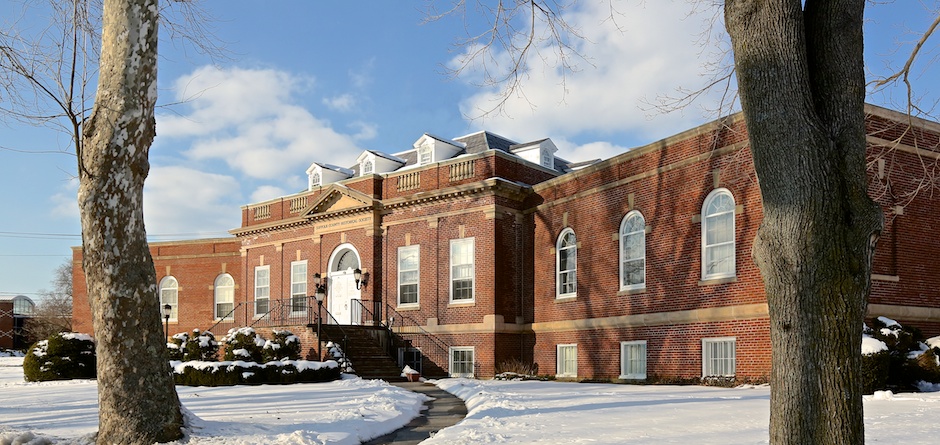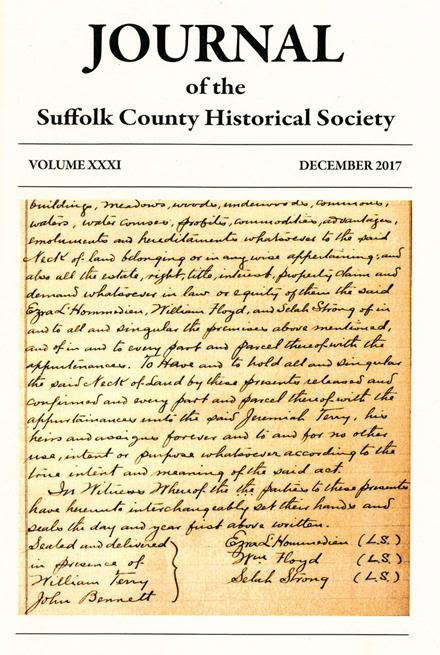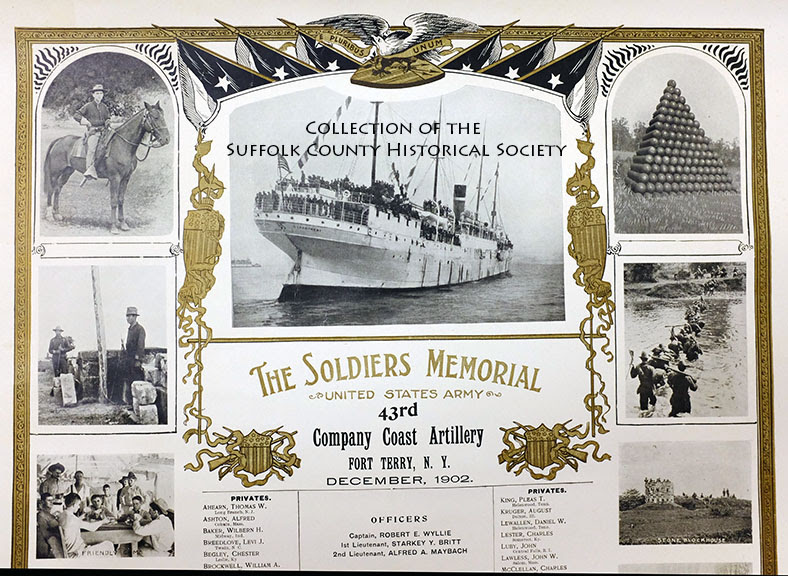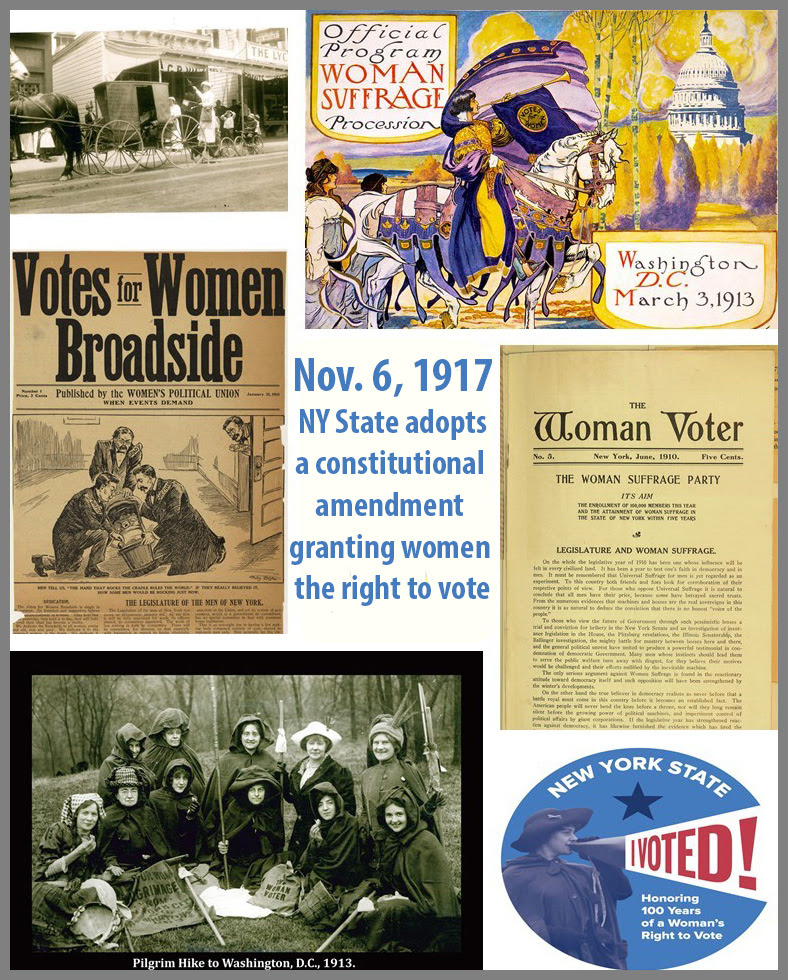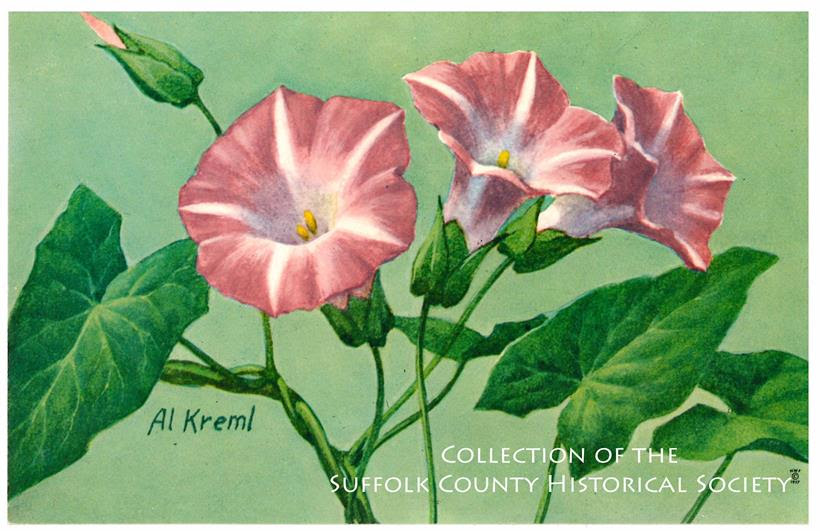SUFFOLK COUNTY HISTORICAL SOCIETY
~~~~~~~~~~~~~~~~~~~~~~~~~~~~~~~~~~~`
MEMBERSHIP DRIVE
If you’ve been enjoying our Photo of the Week, please consider becoming a member of SCHS.
From the Civil War to civil rights, revolutions to restorations, spies to Suffragettes, boatbuilders to bootleggers, and whalers to wineries, Long Island’s history comes alive at the Suffolk County Historical Society!
The Suffolk County Historical Society, founded in 1886, collects and preserves the rich history of Suffolk County and beyond. We offer a history museum, art galleries, a research library and archives, and a multitude of exhibits, programs, and educational lectures and workshops year-round. Our unique collections reflect more than three centuries of Long Island history. Click here to learn about Member Benefits!
——————–
Interested in seeing more historical photos from the Collection of the Suffolk County Historical Society? Spend an afternoon at our Local History Library perusing our extensive archival photography collections. We’re open Weds. – Sat., 12:30 – 4:30 PM.
~~~~~~~~~~~~~~~~~~~~~~~~~~~~~~~~~~~~~~~~~~
PHOTO OF THE WEEK: December 23, 2017 — FROM THE SCHS LIBRARY ARCHIVES
“How shall we know it is us without our past?”
– John Steinbeck
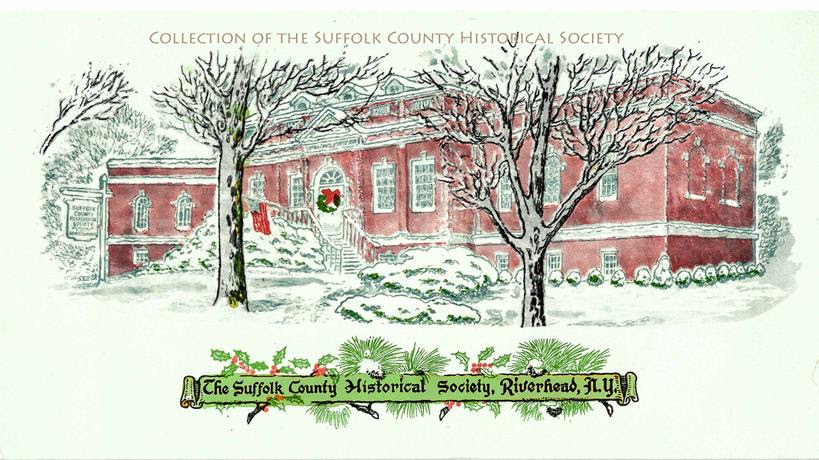
(Image from the Collection of the Suffolk County Historical Society Library Archives.)
The Staff and Board of the
Suffolk County Historical Society
send warm wishes to all of our
friends and supporters
for a wonderful holiday season
and a very happy new year!
Holiday Closure: We will be closed December 27-30, and will reopen on Wednesday, January 3, 2018.
******************************************
Visit: www.suffolkcountyhistoricalsociety.org
To View 2014 Photo of the Week pages click here.
To View 2015 Photo of the Week pages click here.
To View 2016 Photo of the Week pages click here.
~~~~~~~~~~~~~~~~~~~~~~~~~~~~~~~~~~~~~~~~
PHOTO OF THE WEEK: December 16, 2017 — FROM THE SCHS LIBRARY ARCHIVES
“How shall we know it is us without our past?”
– John Steinbeck
Long Island’s Religious History
by Wendy Polhemus-Annibell, Head Librarian
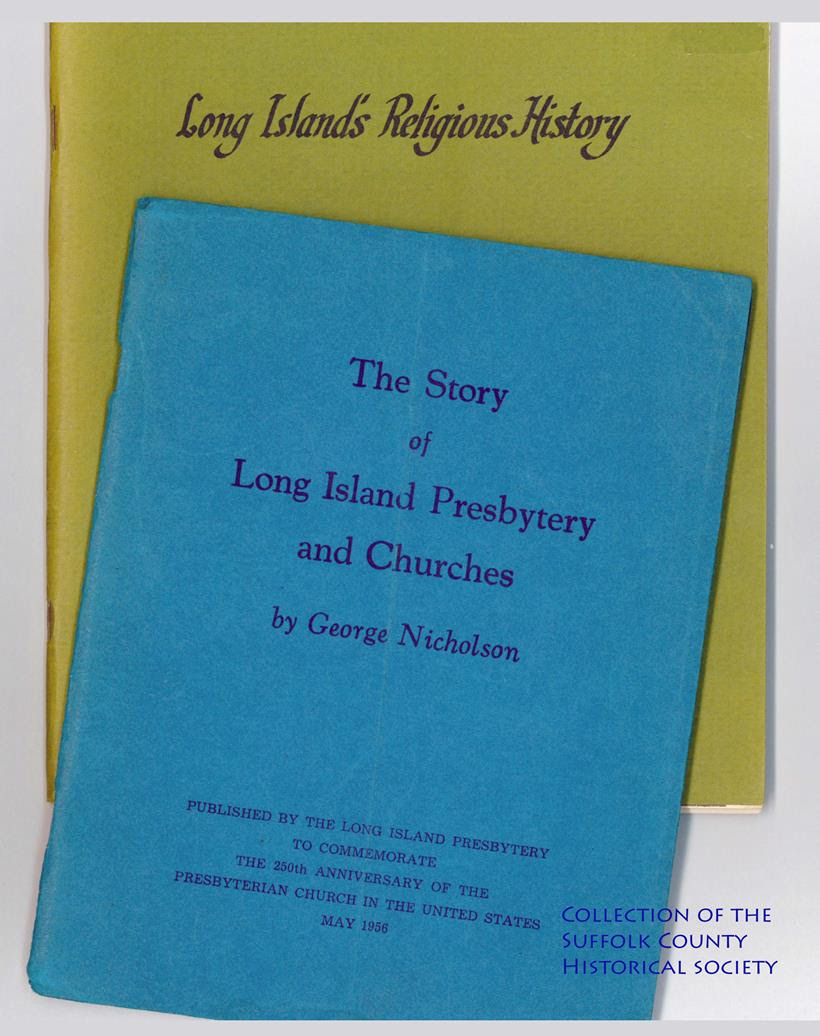
Long Island’s 17th-Century Religious History. (Image from the Collection of the Suffolk County Historical Society Library Archives. Copyright © Suffolk County Historical Society. All rights reserved.)
Just as Long Island was first settled by the English and the Dutch, two nationalities differing in language but sharing a common devotion to political freedom, so the first churches, the Puritan and the Dutch Reformed, had a common heritage in a community-based faith. Long Island at its western end was accessible to the Dutch settlement of New Amsterdam by way of the East River, and the eastern forks were accessible to the English settlements in Massachusetts and Connecticut.
In the case of the English, the initial settlements were church-centered communities. The first two churches were established in the 1640s, one at Southold and the other at Southampton. In Southold, the Rev. John Young came with the first settlers from the New Haven Colony, and the first church was located a short distance from the present one. Southold was slow to relinquish its independent status; as a church, it remained 196 years separate before uniting with the Presbyterian Church. In Southampton, accompanying the first settlers was Rev. Abraham Pierson of Boston, and the site of the original church is located behind the current hospital.
Further to the west, the Dutch built their churches and gathered for worship, but they struggled with a shortage of trained ministers who were willing to make the long journey to settle in the New World. In 1654, a momentous arrival marked a change in the religious history of the area when the St. Charles arrived in New Amsterdam (near today’s Battery Park) carrying the first group of immigrant Jews to the New World and a Dutch minister named Rev. Johannes Theodorus Polhemus. Stuyvesant welcomed the well-trained and able minister, who was quickly assigned to the western Long Island hamlets across the East River. The energetic Rev. Polhemus went on to organize the first Dutch Reformed Church in 1654 at Flatbush, Midwood, and Flatlands (Brooklyn). The last Dutch church to be organized in Brooklyn in the colonial period was at New Utrecht in 1677.
Other denominations were comparatively late to arrive on Long Island, and though the Jewish community in New Amsterdam dates back to the arrival of the St. Charles and Rev. Polhemus in 1654, there were no organized congregations on Long Island until the nineteenth century.
————————————————————
Hot off the press, our 2017 Journal of the Suffolk County Historical Society is chock-full of informative and entertaining local history articles! The Journal is available to members-only. To receive your copy and more, become an SCHS member today or give the gift of membership for the holidays! Visit our Membership page or give us a call at 631-727-2881. Thank you for your support of our efforts to keep our local history alive!
******************************************
Visit: www.suffolkcountyhistoricalsociety.org
To View 2014 Photo of the Week pages click here.
To View 2015 Photo of the Week pages click here.
To View 2016 Photo of the Week pages click here.
~~~~~~~~~~~~~~~~~~~~~~~~~~~~~~~~~~~~~~~~
PHOTO OF THE WEEK: December 9, 2017 — FROM THE SCHS LIBRARY ARCHIVES
“How shall we know it is us without our past?”
– John Steinbeck
Suffolk Traction Co. Streetcar, c. 1911
by Wendy Polhemus-Annibell, Head Librarian

A Suffolk Traction Co. Streetcar, c. 1911. (Image from the Brookhaven Town Pictorial Collection of the Suffolk County Historical Society Library Archives. Copyright © Suffolk County Historical Society. All rights reserved.)
The Suffolk Traction Company was a short-lived streetcar system that operated between Patchogue and Holtsville in about 1911 to 1919. It also included a route that serviced Blue Point, Bayport, and Sayville.
The vehicle was the latest thing in electric streetcar construction. Manufactured by the Federal Storage Battery Car Company, the car used an Edison battery that could run 52 miles without recharging. It was capable of running at a “good rate of speed” depending on the number of batteries with which it was equipped. It was not flawless, however; sometimes it went dead enroute through a short circuit or other cause, and had to be towed in by a team of horses or pushed by another car.
On July 1, 1911, the first streetcar ran down Main Street, Patchogue, and everybody who could climb aboard rode for free. A newspaper article from the time period notes that Patchogue’s street car was running on a regular hourly schedule between the corner of Main Street and Ocean Avenue to the post office in Blue Point. It averaged about 900 passengers on a Saturday from noon to midnight, 750 on a Sunday, and more than 1,000 on a Monday. The tracks were completed to Holtsville and rails were laid in Port Jefferson, but the line was never completed and Holtsville was as far as it got before the company went bankrupt. On October 10, 1919, the last streetcar ran in Patchogue.
******************************************
Visit: www.suffolkcountyhistoricalsociety.org
To View 2014 Photo of the Week pages click here.
To View 2015 Photo of the Week pages click here.
To View 2016 Photo of the Week pages click here.
~~~~~~~~~~~~~~~~~~~~~~~~~~~~~~~~~~~~~~~~
PHOTO OF THE WEEK: December 1, 2017 — FROM THE SCHS LIBRARY ARCHIVES
“How shall we know it is us without our past?”
– John SteinbeckLong Island Street Scenes
by Wendy Polhemus-Annibell, Head Librarian

Long Island Street Scenes, Mid-Twentieth Century. (Images from the Ceylon Anderson Collection of the Suffolk County Historical Society Library Archives. Copyright © Suffolk County Historical Society. All rights reserved.)
Ceylon Anderson (1904-1988) of Riverhead worked as a traffic engineer for the New York State Department of Transportation for over forty years, documenting the development of roads on Long Island from the early winding paths to the modern roadways and highways we know today. Thousands of his street and hamlet images, shot at locations across Long Island, were donated to the Suffolk County Historical Society’s research library. This collage shows a small selection of those images from the mid-twentieth century: Deer Park Rd., New York Ave., and the Smithtown Bypass in 1956; Route 110 in 1949; and Front Street, Greenport, in the 1950s.
******************************************
Visit: www.suffolkcountyhistoricalsociety.org
To View 2014 Photo of the Week pages click here.
To View 2015 Photo of the Week pages click here.
To View 2016 Photo of the Week pages click here.
~~~~~~~~~~~~~~~~~~~~~~~~~~~~~~~~~~~~~~~~
PHOTO OF THE WEEK: November 18, 2017 — FROM THE SCHS LIBRARY ARCHIVES
“How shall we know it is us without our past?”
– John Steinbeck
Thanksgiving
by Wendy Polhemus-Annibell, Head Librarian
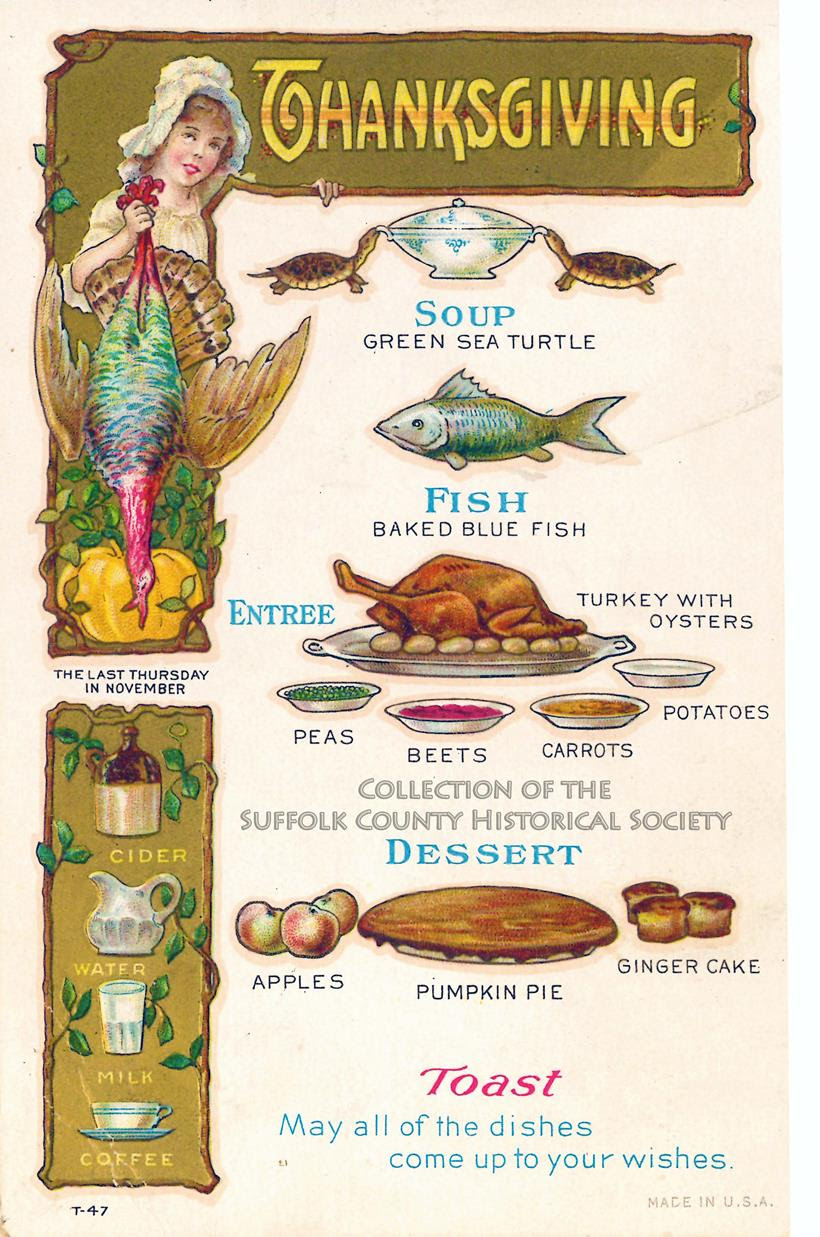
Thanksgiving Postcard, c. 1916. (Image from the Postcard Collection of the Suffolk County Historical Society Library Archives. Copyright © Suffolk County Historical Society. All rights reserved.)
This Thanksgiving greeting was sent in 1916 from Rhode Island to “Miss Ruth Verity” of Champlin Place in Greenport. The Thanksgiving menu of the time period, according to the images displayed on the postcard, included Green Sea Turtle Soup, Baked Blue Fish, Turkey with Oysters, Peas, Beets, Carrots, Potatoes, Apples, Pumpkin Pie, Ginger Cake, Cider, Water, Milk, and Coffee.
It was not until 1863 that Abraham Lincoln issued a presidential proclamation making
Today’s Thanksgiving celebration is a blending of three earlier traditions: the English custom of celebrating a successful harvest, religious observances that combined both prayer and feasting, and the commemoration of the Pilgrims Landing known as Forefathers Day. In New York, one of the best-known holiday customs is the Macy’s New York City Thanksgiving Day Parade, which for ninety-three years has made its way down Broadway on Thanksgiving morning.
The Suffolk County Historical Society wishes all of our members, friends, supporters, and readers a very Happy Thanksgiving holiday!
Holiday Closure: We will be closed on November 23-25, 2017, and will reopen on Weds., November 29.
———————————————————-

Don’t miss the featured art exhibit in our Gish Gallery, Quiet Places of the North Fork by Diane Alec Smith. This collection of acrylic paintings serves as a rich tribute to the beauty and preservation of our local natural environment, as well as a showcase of the extraordinary talents of a lifelong member of our community. On exhibit thru December 22, 2017.
******************************************
Visit: www.suffolkcountyhistoricalsociety.org
To View 2014 Photo of the Week pages click here.
To View 2015 Photo of the Week pages click here.
To View 2016 Photo of the Week pages click here.
~~~~~~~~~~~~~~~~~~~~~~~~~~~~~~~~~~~~~~~~
PHOTO OF THE WEEK: November 11, 2017 — FROM THE SCHS LIBRARY ARCHIVES
“How shall we know it is us without our past?”
– John SteinbeckFort Terry, Plum Island
by Wendy Polhemus-Annibell, Head Librarian
Fort Terry: “The Soldiers Memorial” Poster (upper half), 1902. (From the Collection of the Suffolk County Historical Society Library Archives. Copyright © Suffolk County Historical Society. All rights reserved.)
Located on Plum Island, in the town of Southold, Fort Terry was a heavily armed coastal defense fortification established in 1897 and used from the Spanish American War period through the end of World War II. It was decommissioned in 1948. Named after Alfred Howe Terry (1827-1890) from Connecticut, a Union general in the Civil War, Fort Terry was one of several forts that the U.S. government commissioned along the Long Island Sound to defend against an invading force. By 1914 the fort had eleven gun batteries, including mortar, disappearing, and pedestal batteries, as well as facilities to control an underwater minefield.
Suggested Reading: A World Unto Itself: The Remarkable History of Plum Island, by Ruth Ann Bramson, Geoffrey K. Fleming, & Amy Kasuga Folk (2014).
———————————–
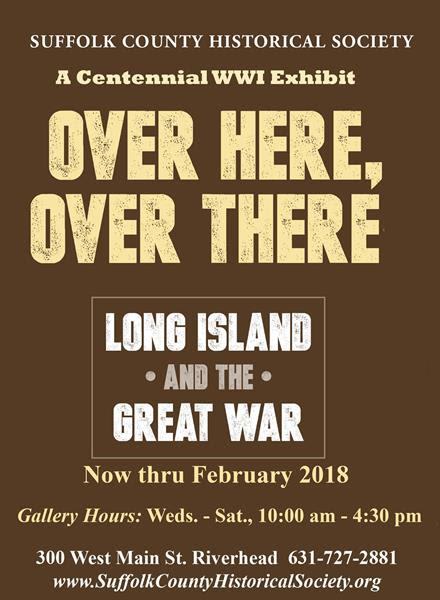 Don’t miss the featured exhibit in our Grand Staas Gallery, Long Island and the Great War, commemorating the centennial of America’s entry into WWI through a remarkable collection of artifacts, documents, and photographs.
Don’t miss the featured exhibit in our Grand Staas Gallery, Long Island and the Great War, commemorating the centennial of America’s entry into WWI through a remarkable collection of artifacts, documents, and photographs.
On display thru February 2018.
******************************************
Visit: www.suffolkcountyhistoricalsociety.org
To View 2014 Photo of the Week pages click here.
To View 2015 Photo of the Week pages click here.
To View 2016 Photo of the Week pages click here.
~~~~~~~~~~~~~~~~~~~~~~~~~~~~~~~~~~~~~~~~
PHOTO OF THE WEEK: November 4, 2017 — FROM THE SCHS LIBRARY ARCHIVES
“How shall we know it is us without our past?”
– John SteinbeckCelebrating NYS Suffrage Centennial
by Wendy Polhemus-Annibell, Head Librarian
Votes for New York Women: Celebrating Our State Suffrage Centennial. (Image collage from the Collection of the Suffolk County Historical Society Library Archives. Copyright © Suffolk County Historical Society. All rights reserved.)
On November 6, 1917, New York’s male voters headed to the polls and voted in favor of a state constitutional amendment granting New York women the right to vote. Monday will mark the 100th anniversary of that amendment to our state constitution, which was overwhelming approved by a margin of 53.92% to 46.08% statewide.
In New York, as in the rest of the United States, however, the road toward gender equality was not easy. Women had very limited rights when the new nation was founded, and it would take decades for the foundation of the women’s movement to form. As with other social justice movements, it’s easy to forget that women’s right to vote was neither inevitable nor quickly won. But by 1917, New York’s successful referendum helped set the stage for the adoption of the 19th Amendment nationwide three years later.
The 100th anniversary of women’s suffrage in New York has been marked by the Suffolk County Historical Society Museum’s exhibit and programs, including our “Votes for New York Women: A Centennial Exhibit” profiling Long Island women involved in the suffrage movement, and the upcoming book talk on The Suffragents by Brooke Kroeger later this month. On Tuesday, Election Day, at your polling place, look for the official centennial sticker, “I Voted! Honoring 100 Years of a Woman’s Right to Vote,” which features the image of Rosalie Gardiner Jones, one of Long Island’s most noted suffragists.
——————————————-
Brooke Kroeger’s new book, The Suffragents: How Women Used Men to Get the Vote, will be the focus of a BOOK & BOTTLE talk on Thursday, November 16, at 6:00 PM.
Members Free; Non-Members $5. Includes wine & cheese and book sale & signing. Space is limited! Call soon to reserve: 631-727-2881 x100.
******************************************
Visit: www.suffolkcountyhistoricalsociety.org
To View 2014 Photo of the Week pages click here.
To View 2015 Photo of the Week pages click here.
To View 2016 Photo of the Week pages click here.
~~~~~~~~~~~~~~~~~~~~~~~~~~~~~~~~~~~~~~~~
PHOTO OF THE WEEK: October 28, 2017 — FROM THE SCHS LIBRARY ARCHIVES
“How shall we know it is us without our past?”
– John Steinbeck
A Thrilling Hallowe’en
by Wendy Polhemus-Annibell, Head Librarian

Halloween Postcard, 1909. (Image from the Holiday Postcard Collection of the Suffolk County Historical Society Library Archives. Copyright © Suffolk County Historical Society. All rights reserved.)
Back in 1909, when it cost two cents for a stamp, postcards were a popular way to share holiday greetings with friends and family.This postcard was addressed to Mrs. Kate M. Edwards of Sag Harbor, with a question from the sender: “Does this postal go the right way? – Olive.
Click here for an interesting history of the origins of the Halloween holiday.
The Suffolk County Historical Society wishes all of our friends, members, and readers a happy and safe Halloween!
Ghosts and goblins, spooks galore
Scary witches at your door
Jack-o-lanterns smiling bright
Wishing you a Haunting Night!
——————————————–
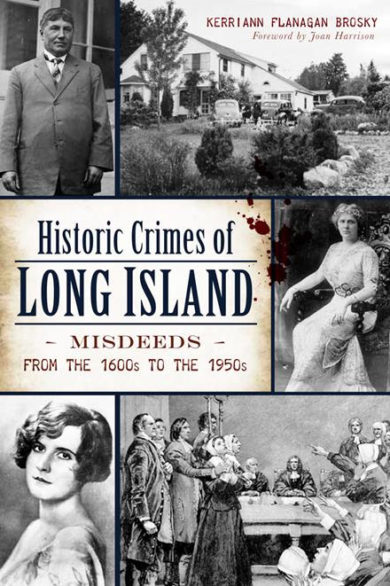
Kerriann Flanagan Brosky’s new book, Historic Crimes of Long Island: Misdeeds from the 1600s to the 1950s, will be the focus of a BOOK & BOTTLE talk on Thursday, November 2, at 6:00 PM.
Members Free; Non-Members $5. Includes wine & cheese and book sale and signing.
Space is limited! RSVP required. Call soon to reserve: 631-727-2881 x100.
~~~~~~~~~~~~~~~~~~~~~~~~~~~~~~~~~~~~~~~~
PHOTO OF THE WEEK: October 14, 2017 — FROM THE SCHS LIBRARY ARCHIVES
“How shall we know it is us without our past?”
– John Steinbeck
Peconic River Waterfront, c. 1890
by Wendy Polhemus-Annibell, Head Librarian
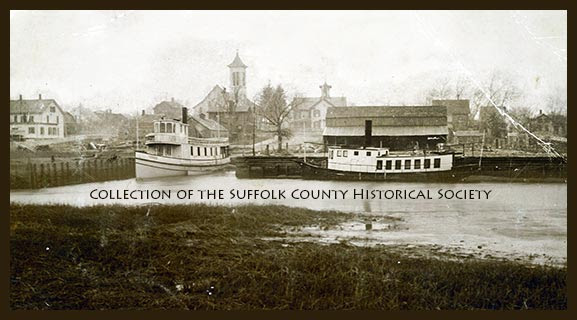
Peconic River Waterfront, c. 1890. (Image from the Collection of the Suffolk County Historical Society Library Archives. Copyright © Suffolk County Historical Society. All rights reserved.)
Looking north from the south side of the Peconic River in downtown Riverhead, the steamer Teddy and another vessel wait to take passengers or cargo aboard in the 1890s. In the background is the familiar Riverhead United Methodist Church and the old Riverhead Union School building (now the white house on Main Street known for its beautiful rose garden). Also in view in this extraordinary image is McDermott Street, then known as Dock Street. Before 1900, ships and boats of every shape and size plied the waters of the Peconic River and the Peconic Bay. Water transportation was the most efficient means of travel until the construction of major highways connected eastern Long Island with New York City.
******************************************
Visit: www.suffolkcountyhistoricalsociety.org
To View 2014 Photo of the Week pages click here.
To View 2015 Photo of the Week pages click here.
To View 2016 Photo of the Week pages click here.
~~~~~~~~~~~~~~~~~~~~~~~~~~~~~~~~~~~~~~~~
PHOTO OF THE WEEK: October 6, 2017 — FROM THE SCHS LIBRARY ARCHIVES
“How shall we know it is us without our past?”
– John Steinbeck
Long Island Suffrage Leader Rosalie G. Jones
by Wendy Polhemus-Annibell, Head Librarian
Looking north from the south side of the Peconic River in downtown Riverhead, the steamer Teddy and another vessel wait to take passengers or cargo aboard in the 1890s. In the background is the familiar Riverhead United Methodist Church and the old Riverhead Union School building (now the white house on Main Street known for its beautiful rose garden). Also in view in this extraordinary image is McDermott Street, then known as Dock Street. Before 1900, ships and boats of every shape and size plied the waters of the Peconic River and the Peconic Bay. Water transportation was the most efficient means of travel until the construction of major highways connected eastern Long Island with New York City.
******************************************
Visit: www.suffolkcountyhistoricalsociety.org
To View 2014 Photo of the Week pages click here.
To View 2015 Photo of the Week pages click here.
To View 2016 Photo of the Week pages click here.
~~~~~~~~~~~~~~~~~~~~~~~~~~~~~~~~~~~~~~~~~~~~
PHOTO OF THE WEEK: October 6, 2017 — FROM THE SCHS LIBRARY ARCHIVES
“How shall we know it is us without our past?”
– John Steinbeck
Long Island Suffrage Leader Rosalie G. Jones
by Wendy Polhemus-Annibell, Head Librarian
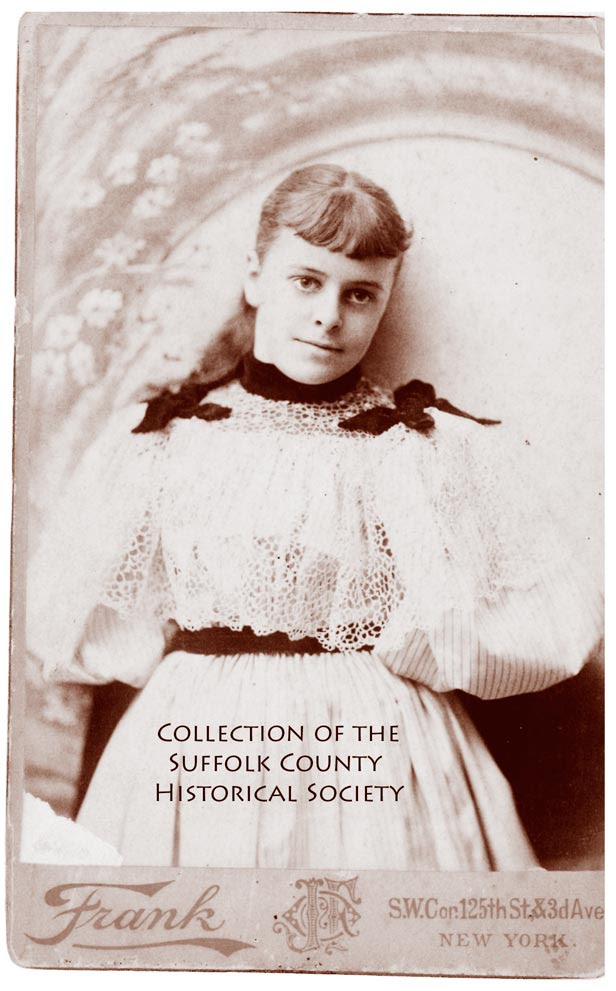
Long Island Suffrage Leader Rosalie G. Jones at Age 12, February 1895. (Image from the Collection of the Suffolk County Historical Society Library Archives. Copyright © Suffolk County Historical Society. All rights reserved.)
Rosalie Gardiner Jones was a flamboyant and headline-grabbing leader of women’s rights, entering the suffrage movement at age twenty-eight. A wealthy Oyster Bay-Cold Spring Harbor socialite, she found marching to Washington for women’s rights much more enjoyable than drinking afternoon tea with the ladies.
Rosalie joined the Nassau County branch of the National American Woman Suffrage Association and soon was serving as its president. She found herself more attracted to the militant “suffragettes” of London, rather than the more passive American suffragists. Known as “General Jones” among both her followers and by the press, her “pilgrimages” (as she called them) to Albany, to Washington, DC, and across Suffolk County in a horse-drawn wagon helped spread the “Votes for Women” message far and wide. Under the headline “Gen. Rosalie Jones Flies for Suffrage,” the New York Times reported on one of her stunts in 1913, when she was taken up in a two-seat Wright biplane over Staten Island to toss out yellow Votes for Women leaflets.
Jones planned successful suffrage hikes to Albany in 1912 to present a suffrage petition to the governor, and to Washington, DC, in 1913, where a large suffrage parade was being planned for March 3, the day before the inauguration of the new president, Woodrow Wilson. Jones and her followers set out on the 245-mile March to Washington carrying a banner that proclaimed: “Criminals and the insane can’t vote, neither can I, what about it?” The women’s suffrage issue was front and center on March 3, 1913, when over 5,000 women marched down Pennsylvania Avenue to the cheers of thousands of onlookers.
Just yesterday Governor Andrew M. Cuomo announced that the winning design in the New York State Suffrage Centennial “I Voted” Sticker Competition is an entry that features the image of Long Island’s own Rosalie Jones. The anniversary sticker, celebrating the 100th anniversary of New York women getting the right to vote in 1917, will be distributed throughout the state at polling places on Election Day, November 7, 1917.
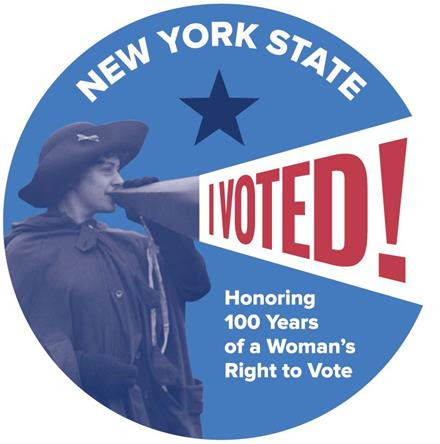
***********************************************************************************
ABOUT Our PHOTO OF THE WEEK Series
The Suffolk County Historical Society’s PHOTO OF THE WEEK Series is created by head research librarian Wendy Polhemus-Annibell using historic primary source materials from our local history library’s extensive archives. To subscribe, visit our website or send an email request to Wendy at librarian@schs-museum.org
Interested in seeing more historical documents from the Collection of the Suffolk County Historical Society? Spend an afternoon at our Local History Research Library perusing our extensive collections. We’re open Weds. – Sat., 12:30 – 4:30 PM.
To view our Photo of the Week archives, visit our website at www.
******************************************
Visit: www.suffolkcountyhistoricalsociety.org
To View 2014 Photo of the Week pages click here.
To View 2015 Photo of the Week pages click here.
To View 2016 Photo of the Week pages click here.
~~~~~~~~~~~~~~~~~~~~~~~~~~~~~~~~~~~~~~~~~~~~
PHOTO OF THE WEEK: September 17, 2017 — FROM THE SCHS LIBRARY ARCHIVES
“How shall we know it is us without our past?”
– John Steinbeck
The Hurricane of 1938
by Wendy Polhemus-Annibell, Head Librarian
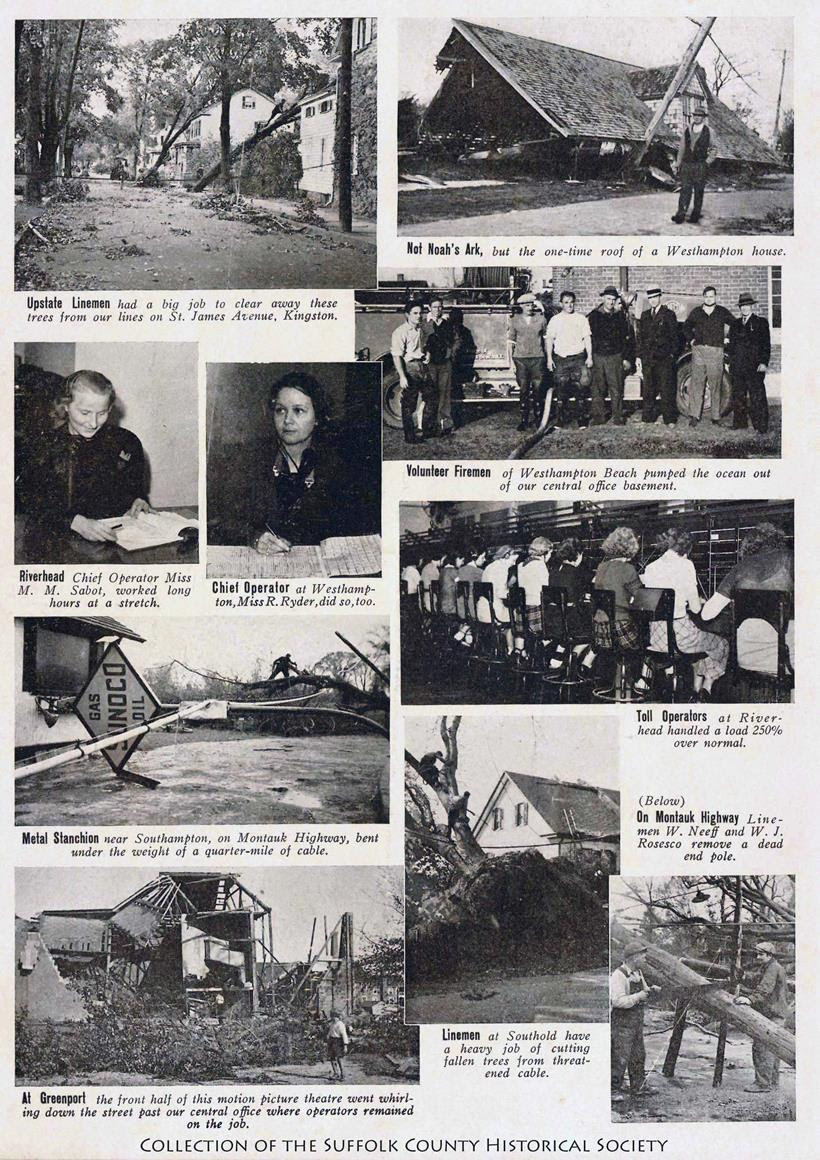
The Hurricane of 1938. (Image from the Collection of the Suffolk County Historical Society Library Archives. Copyright © Suffolk County Historical Society. All rights reserved.)
Seventy-nine years ago almost to the day, the most destructive hurricane in U.S. history at the time slammed into the Northeast and Long Island without warning, leaving death and devastation in its wake. With the development of storm-tracking radar still a few years off, the hurricane took residents by surprise. After several days of rain, the 200-mile-wide storm roared ashore near Westhampton at high tide, a category 3 with sustained winds of 120 mph. Tides surged as high as 17 feet above normal, with eyewitnesses later describing walls of water over 12 feet tall rolling in from the ocean. The eye of the storm was itself 43 miles wide, stretching from Brentwood to Mattituck as the storm hit the island.
These images are from a Telephone Workers Supplement to Telephone Review, published in October 1938. One story recounted in the publication describes telephone workers in or around Westhampton, “which suffered the heaviest loss of life and damage to shorefront homes.” Amazingly, telephone service at the time appeared to work during the storm. The supplement describes “the courage of the telephone operators who stayed at their boards while huge walls of water swept around the building, and while boats and debris of wrecked homes bumped the telephone company’s central office wall. They answered the frantic calls for help from those marooned by the rising sea, assuring them that their plight was known and that help was on the way.“
Sometimes referred to as the Long Island Express, the 1938 hurricane occurred before such storms were given names. According to the Bridgehampton News in Oct. 1938, the storm caused an estimated $24 million in damage to private and public property in Suffolk County. It also felled 270 million trees, damaged 200,000 buildings, beached thousands of boats, and threw LIRR trains off their tracks. Over 600 people died from Long Island north to New England, including 50 on Long Island.
******************************************
Visit: www.suffolkcountyhistoricalsociety.org
To View 2014 Photo of the Week pages click here.
To View 2015 Photo of the Week pages click here.
To View 2016 Photo of the Week pages click here.
~~~~~~~~~~~~~~~~~~~~~~~~~~~~~~~~~~~~~~~~~~~~
PHOTO OF THE WEEK: September 17, 2017 — FROM THE SCHS LIBRARY ARCHIVES
“How shall we know it is us without our past?”
– John SteinbeckYaphank School House, c. 1910
by Wendy Polhemus-Annibell, Head Librarian
Yaphank School House, c. 1910. (Image from the Collection of the Suffolk County Historical Society Library Archives. Copyright © Suffolk County Historical Society. All rights reserved.)
This image of school children enjoying recess time outside their octagonal-shaped school house in Yaphank is from the turn of the century. However, the building was likely built in the mid-to-late 1800s, when eight-sided buildings were all the rage. Some still survive on Long Island, in Huntington, Brentwood, and elsewhere. Octagonal-shaped buildings were thought to be good for the health. That notion appears to have come from a nineteenth-century book titled Octagon House: A Home for All, in which author Orson Fowler claimed the increased light and ventilation of the building’s shape contributed to a healthier indoor environment.
******************************************
Visit: www.suffolkcountyhistoricalsociety.org
To View 2014 Photo of the Week pages click here.
To View 2015 Photo of the Week pages click here.
To View 2016 Photo of the Week pages click here.
_______________________________________________________
PHOTO OF THE WEEK: September 9, 2017 — FROM THE SCHS LIBRARY ARCHIVES
“How shall we know it is us without our past?”
– John SteinbeckCranberry Industry
by Wendy Polhemus-Annibell, Head Librarian
[To view Fullerton photo, visit web version] Cranberry Pickers, Brown’s Marsh, Calverton, 1899, by Hal B. Fullerton. (Image from the Harry T. Tuthill Fullerton Collection of the Suffolk County Historical Society Library Archives. Copyright © Suffolk County Historical Society. All rights reserved.)
In the early 1900s, Suffolk County was the third largest producer of cranberries in the United States, behind only Wisconsin and Massachusetts. Many millers along the Peconic River began around 1875 to switch from using the water to power mill wheels to growing cranberries in bogs. Most of Suffolk County’s cranberry marshes were located in the Riverhead-Calverton-Manorville area along the wetlands of the Peconic River. The largest cranberry operation was run by Sylvester Woodhull of Riverhead. Other growers included the Perkins Co. of Riverhead, E. L. Brown of Calverton, and George L. Davis of Manorville. In 1897 the Woodhull Marsh produced over 3,000 bushels of cranberries, which sold for $3 per bushel at the time.
A variety of factors contributed to the eventual decline of the cranberry industry on Long Island. The small bogs of Suffolk County were unable to compete with the larger producers in Massachusetts and New Jersey; the descendants of the Suffolk families that operated the bogs were uninterested in carrying on the agricultural business; and the difficulties of weed and pest control intensified when a carcinogenic herbicide, amino triazole, was banned in 1959. During the peak years of cranberry production, however, some 25,000 bushels were harvested annually from the Peconic River-area cranberry marshes.
Visit us this weekend, Sept. 9 and 10, at the 37th Annual Hallockville Country Fair and Craft Show, where the Suffolk County Historical Society booth will celebrate our county’s agricultural history and offer a free raffle of framed historic photographs from our Hal B. Fullerton collection. The museum farm’s festival features the wares of local craft guilds and artisan vendors, a tractor pull and display, livestock and farm animals, children’s activities, guided tours of the historic buildings, and more. Click here for more information.
******************************************
Visit: www.suffolkcountyhistoricalsociety.org
To View 2014 Photo of the Week pages click here.
To View 2015 Photo of the Week pages click here.
To View 2016 Photo of the Week pages click here.
_______________________________________________________
PHOTO OF THE WEEK: September 1, 2017 — FROM THE SCHS LIBRARY ARCHIVES
“How shall we know it is us without our past?”
– John Steinbeck
Labor Day
by Wendy Polhemus-Annibell, Head Librarian

Picturesque Long Island Beach. (From the Postcard Collection of the Suffolk County Historical Society Library Archives.)
What is the origin of Labor Day as a holiday? Observed on the first Monday in September, Labor Day pays tribute to the contributions and achievements of American workers. It was created by the labor movement in the late nineteenth century and became a federal holiday in 1894. On Long Island, the holiday marks the unofficial end of the summer season.
The Suffolk County Historical Society wishes all of our friends and followers a happy and safe Labor Day weekend.
Holiday Closure: We will be closed on Saturday, Sept. 2, 2017, for the holiday weekend. We will reopen on Wednesday, Sept. 6
******************************************
Visit: www.suffolkcountyhistoricalsociety.org
To View 2014 Photo of the Week pages click here.
To View 2015 Photo of the Week pages click here.
To View 2016 Photo of the Week pages click here.
_______________________________________________________
~~~~~~~~~~~~~~~~~~~~~~~~~~~~~~~~~~~~~~~~~~~~
PHOTO OF THE WEEK: August 26, 2017 — FROM THE SCHS LIBRARY ARCHIVES
“How shall we know it is us without our past?”
– John Steinbeck
Main Street, Stony Brook
by Wendy Polhemus-Annibell, Head Librarian
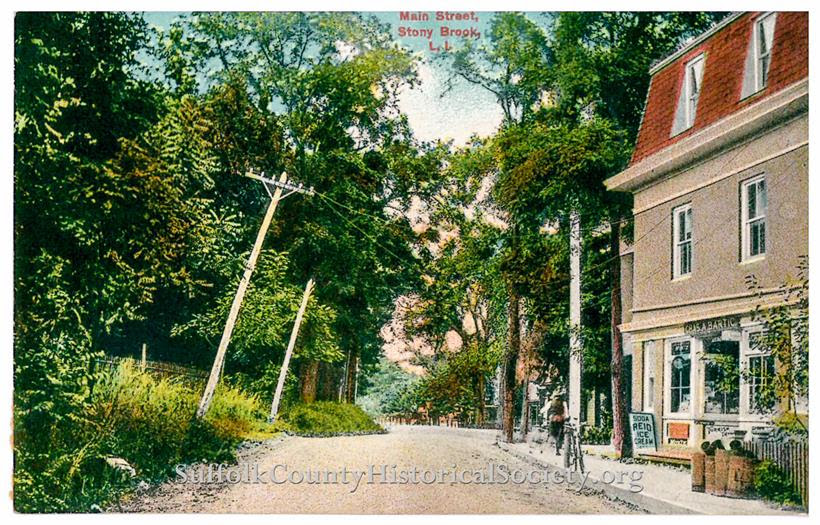
Main Street, Stony Brook, Postcard. (From the Postcard Collection of the Suffolk County Historical Society Library Archives. Image © copyright Suffolk County Historical Society. All rights reserved.)
Historian Richard M. Bayles, writing in 1873, describes the Stony Brook of that time in his Historical Sketches:
“Stony Brook is a village of seven hundred inhabitants on the east side of Stony Brook Harbor, in the northwest part of [Brookhaven] town. The locality was called by the Indians Wopowog, and from the immense quantities of shells found in the neighborhood, is supposed to have been a favorite place of residence with the natives…. Ship building is engaged in to some extent, and a new set of marine railways has recently been laid down for the accommodation of repairs. Large quantities of cordwood have been shipped from this port during years past. An ancient mill site is situated on a small stream of water, which empties into the harbor at this point. The village lines a single street about a mile and a half in length and running an average direction of north and south….
“The village contains two flourishing district schools, two hotels…, five stores, and a number of workshops. The manufacture of pianos was carried on some years ago by C. S. Seabury. Two docks extend into the harbor from the lower part of the village, and a line of packets [operate to] New York…. A Methodist church was built in 1817, which was sold and coverted into a dwelling…, and a new one erected in 1860 in the northeast part of the village…. A weekly newspaper, the Independent Press, was started in the village by H. Markham in 1865. It was moved to Port Jefferson in 1868.”
– Richard M. Bayles, Historical and Descriptive Sketches of Suffolk County.
******************************************
Visit: www.suffolkcountyhistoricalsociety.org
To View 2014 Photo of the Week pages click here.
To View 2015 Photo of the Week pages click here.
To View 2016 Photo of the Week pages click here.
_______________________________________________________
PHOTO OF THE WEEK: August 19, 2017 — FROM THE SCHS LIBRARY ARCHIVES
“How shall we know it is us without our past?” – John Steinbeck
Visit A European Village: Polish Town Fair
by Wendy Polhemus-Annibell, Librarian

Polish Town Fair Map, “Visit a European Village Without Leaving the U.S.A.,” Riverhead, 1980. (From the Collection of the Suffolk County Historical Society Library Archives. Image © copyright Suffolk County Historical Society. All rights reserved.)
With Riverhead’s annual Polish Town Fair under way this weekend, we found a map of the area in a 1980 Polish Town Fair Supplement in our library collection. The publication’s front cover reads: WITAMY Means Welcome to Polish Town, USA!
How it all started: Back in 1975, a small group of Riverhead citizens of Polish descent met to discuss plans for the national bicentennial celebration, and came upon the idea of a street fair to be held in the section of Riverhead known as Polish Town, home to generations of immigrants from Poland beginning in the late nineteenth century. The idea was to create a street fair that gave visitors the experience of a Polish village–through music, dance, and, of course, traditional foods. The fair was also intended as a tribute to the original Polish immigrants, men and women who came to Riverhead to work on farms, build a beautiful church, and grow a community. St. Isidore’s Church, built in 1906, is the oldest Polish Catholic church on Long island.
***********************
The Suffolk County Historical Society’s Research Library
is seeking to grow its genealogy resources on Polish immigrants
to the Riverhead area and all of Suffolk County.
If you can help, please contact our library staff at
631-727-2881 x103 or librarian@schs-museum.org******************************************
Visit: www.suffolkcountyhistoricalsociety.org
To View 2014 Photo of the Week pages click here.
To View 2015 Photo of the Week pages click here.
To View 2016 Photo of the Week pages click here.
_______________________________________________________
PHOTO OF THE WEEK: August 12, 2017 — FROM THE SCHS LIBRARY ARCHIVES
“How shall we know it is us without our past?” – John Steinbeck
Journal of the House of Representatives of the United States, 1789
by Wendy Polhemus-Annibell, Librarian
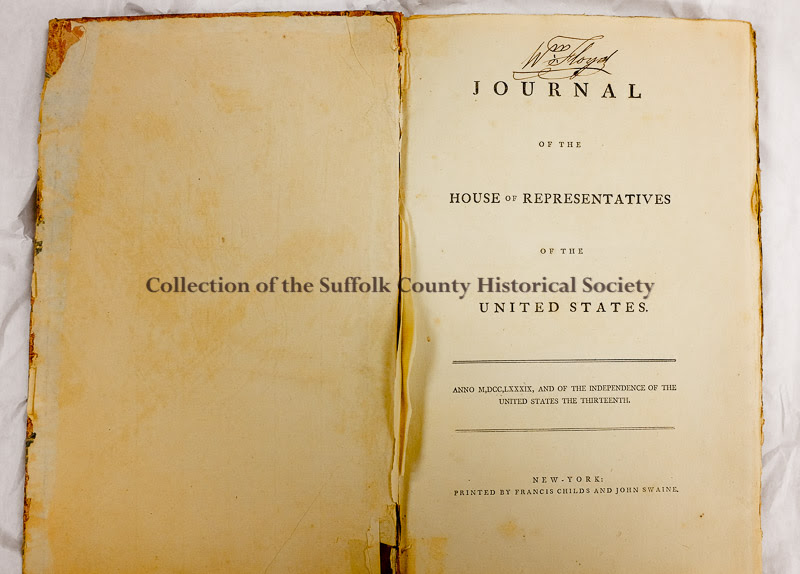
Journal of the House of Representatives of the United States, First Session of the First U.S. Congress, Signed by William Floyd, 1789. (From the Collection of the Suffolk County Historical Society Library Archives. Image © copyright Suffolk County Historical Society. All rights reserved.)
The First United States Congress, consisting of the U.S. Senate and the U.S. House of Representatives, met from 1789 to 1791, during the first two years of George Washington’s presidency, first at Federal Hall in New York City and later at Congress Hall in Philadelphia. With the initial meeting of the first session of the First U.S. Congress on March 4, 1789, the U.S. government officially began operations under the frame of governance established by the 1787 Constitution.
The original 1789 Journal of the House of Representatives in our research library bears the signature of William Floyd of Suffolk County, who was elected to the First U.S. Congress in 1789. Floyd was also a signer of the Declaration of Independence and had served as general in the Suffolk County Militia during the American Revolution. He spent many years in public service, including as a delegate to the Continental Congress (1774-1776), as a presidential elector for George Washington, and as a New York State Senator. Born in Mastic in 1734, to Nicoll Floyd and Tabitha Smith Floyd, William became a major land proprietor at age twenty when he inherited the family’s 4,400-acre estate in Mastic. Today the property is known as the William Floyd Estate.
To view this 164-page Journal, a treasure from our national and local past, visit our research library during operating hours, Wednesday through Saturday, 12:30 pm – 4:30 pm. No appointment is necessary, and a librarian is always available to assist you with your local history and family research. For more information, visit our website or call us at 631-727-2881 x103.
******************************************
Visit: www.suffolkcountyhistoricalsociety.org
To View 2014 Photo of the Week pages click here.
To View 2015 Photo of the Week pages click here.
To View 2016 Photo of the Week pages click here.
_______________________________________________________
PHOTO OF THE WEEK: August 5, 2017 — FROM THE SCHS LIBRARY ARCHIVES
“How shall we know it is us without our past?” – John Steinbeck
Bridgehampton Sports Car Road Races
by Wendy Polhemus-Annibell, Librarian

Bridgehampton Sports Car Road Races, Program Cover Page, May 24, 1952. (From the Collection of the Suffolk County Historical Society Library Archives. Image copyright © Suffolk County Historical Society. All rights reserved.)
The original Bridgehampton Sports Car Road Races were held on the streets of Bridgehampton as early as 1915. According to the 1952 program in our library collection, the original three-mile route “started in front of Motta’s Restaurant on Montauk Highway, going west to Shanahan’s corner, then south down Halsey Lane on a fast run to Paul’s Lane, east to Ocean Road, north to the monument in the village, and west down the highway to the finish.” The 1952 event, sponsored by the Bridgehampton Lions Club under the auspices of the Sports Car Club of America (SCCA), included several races of sports cars with similar engine sizes and performance ratings.
In 1953, a community group of racers and enthusiasts formed the Bridgehampton Road Races Corporation to buy land for a private track. The group settled on a 550-acre plot overlooking Noyac Bay and bought the site for $55,000. When the 2.86-mile track was opened in 1957, it was an immediate success. Fans enjoyed the Bridgehampton Race Circuit – commonly referred to as “The Bridge” – over the next several decades, flocking to see famed racers who came from all over to compete at one of the country’s most challenging race courses. The last race held at the track occurred in the 1970s, and in the late 1990s the track was dismantled for a golf course and housing development project.
To view our collection of Bridgehampton Sports Car Road Racesprograms, stop by during operating hours, Wednesday through Saturday,12:30 pm – 4:30 pm. No appointment is necessary, and a librarian is always available to assist you with your local history and family research. For more information, visit our website or call us at 631-727-2881 x103.
******************************************
SCHS Photo of the Week: Click Here to Visit Webpage.
Visit: www.suffolkcountyhistoricalsociety.org
To View 2014 Photo of the Week pages click here.
To View 2015 Photo of the Week pages click here.
To View 2016 Photo of the Week pages click here.
_______________________________________________________
PHOTO OF THE WEEK: July 29, 2017 — FROM THE SCHS LIBRARY ARCHIVES
“How shall we know it is us without our past?” – John Steinbeck
Map of Sound Beach, c. 1930
by Wendy Polhemus-Annibell, Librarian
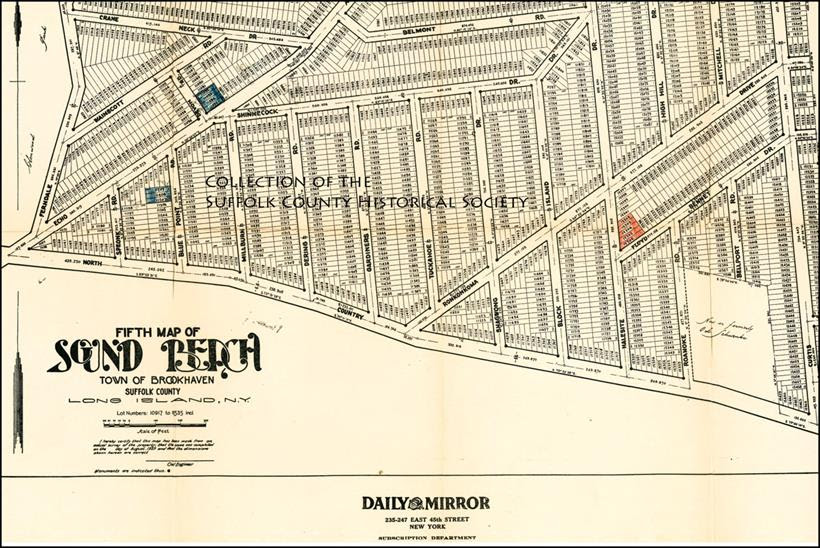
Daily Mirror Map of Sound Beach, c. 1930. (From the Collection of the Suffolk County Historical Society Library Archives. Image copyright © Suffolk County Historical Society. All rights reserved.)
Sound Beach came about in the late 1920s as a result of a newspaper’s strategy to boost its circulation numbers. The NYC-based Daily Mirror purchased over a thousand acres in Sound Beach in 1928, and the following year began advertising 20 x 100-foot lots for $89.50. The only requirements were a $12.50 down payment, a monthly payment of $3.50 until the loan was paid off, and maintaining a one-year renewable subscription to the newspaper. Buyers showed up and purchased the 2,000-square-foot lots by the Sound; some pitched tents and erected outhouses on their newly purchased lots until they were able to build their summer cottages. They got by without electricity or running water at first. After World War II, most of the original Sound Beach summer cottages were converted to year-round homes.
To view this map or any of the many other historic maps in our library collection, stop by during operating hours, Wednesdaythrough Saturday,12:30 – 4:30 pm. No appointment is necessary. A certified librarian is always available to assist you with your local history and family research. For more information, visit our website or call us at 631-727-2881 x103.
******************************************
SCHS Photo of the Week: Click Here to Visit Webpage.
Visit: www.suffolkcountyhistoricalsociety.org
To View 2014 Photo of the Week pages click here.
To View 2015 Photo of the Week pages click here.
To View 2016 Photo of the Week pages click here.
_______________________________________________________
PHOTO OF THE WEEK: July 23, 2017 — FROM THE SCHS LIBRARY ARCHIVES
“How shall we know it is us without our past?” – John Steinbeck
Journal of the NY State Senate, 1824
by Wendy Polhemus-Annibell, Librarian
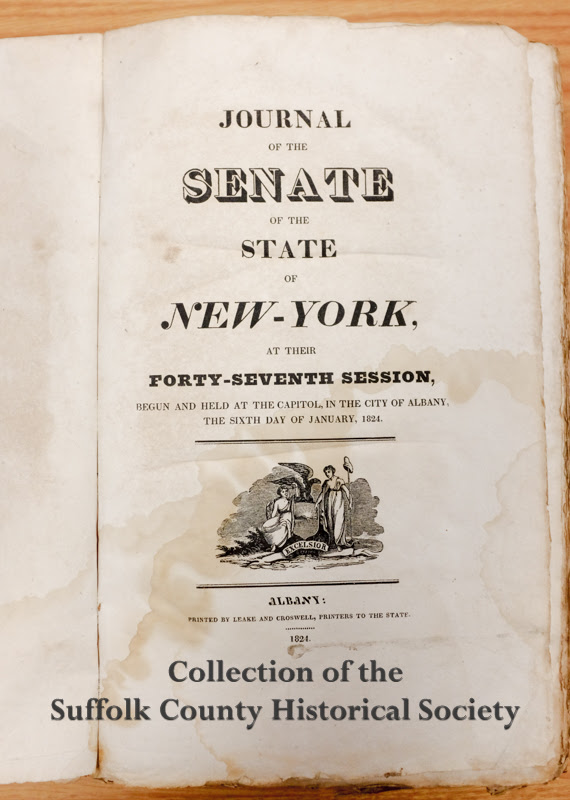
Journal of the Senate of the State of New-York, 1824. (From the Collection of the Suffolk County Historical Society Library Archives. Image copyright © Suffolk County Historical Society. All rights reserved.)
The library archives of the Suffolk County Historical Society includes this 1824 bound volume titled Journal of the Senate of the State of New-York at Their Forty-Seventh Session, Begun and Held at the Capitol, in the City of Albany, the Sixth Day of January 1824.
The 47th New York State Senate included Senators Walter Bowne, John Lefferts, and David Gardiner in the First District, and Stephen Thorn, John Sudam, and William Nelson in the Second District. This sizeable volume includes 546 pages of chronological description of the New York State Senate’s activities, as well as an appendix, occupying an additional 150 pages, on the subject of poverty or “pauperism” in counties and towns across the state.
To view this Senate book, or any of the other thousands of primary source materials available in our collection, visit our library during operating hours, Wednesday through Saturday,12:30 – 4:30 pm. No appointment is necessary. A certified librarian is always available to assist you with your local history and family research. For more information, visit our website or call us at 631-727-2881 x103.
******************************************
SCHS Photo of the Week: Click Here to Visit Webpage.
Visit: www.suffolkcountyhistoricalsociety.org
To View 2014 Photo of the Week pages click here.
To View 2015 Photo of the Week pages click here.
To View 2016 Photo of the Week pages click here.
_______________________________________________________
PHOTO OF THE WEEK: July 14, 2017 — FROM THE SCHS LIBRARY ARCHIVES
“How shall we know it is us without our past?” – John Steinbeck
Old Schoolhouse, Smithtown, circa 1802
by Wendy Polhemus-Annibell, Librarian
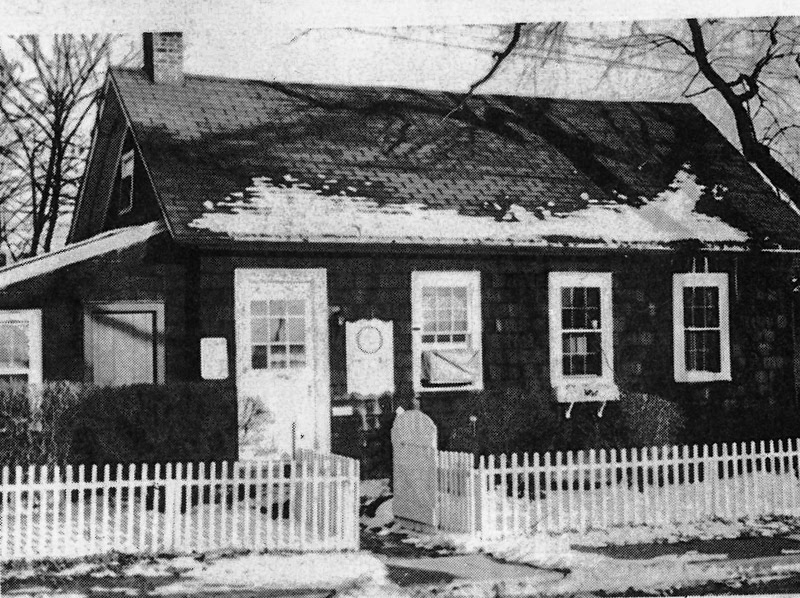
Old Schoolhouse, Smithtown, erected circa 1802. The schoolhouse was built around 1802 in the Village of the Branch, Smithtown, on the land of Epenetus Smith II, between his tavern and the Presbyterian Meeting House. The one-room school had a large fireplace but the classroom had no maps or blackboards, so the students wrote on pieces of slate with chalk. The classroom also had no plumbing and was heated by a small, wood stove.
When the school district was organized under state law in 1816, the district purchased the building. Walt Whitman taught at the school in 1837-38. The original schoolhouse was replaced in 1869 by New Academy. James Darling bought the old building for $300 in 1868, and moved it to its present location on Singer Lane (old Route 111), where it’s been used as a residence and as the site of local businesses.
Suggested Readings: Noel J. Gish, Smithtown, New York, 1660– 1929: Looking Back Through the Lens, and NYSRTA, Old Schoolhouses of Long Island.
******************************************
SCHS Photo of the Week: Click Here to Visit Webpage.
Visit: www.suffolkcountyhistoricalsociety.org
To View 2014 Photo of the Week pages click here.
To View 2015 Photo of the Week pages click here.
To View 2016 Photo of the Week pages click here.
_______________________________________________________
PHOTO OF THE WEEK: July 8, 2017 — FROM THE SCHS LIBRARY ARCHIVES
“How shall we know it is us without our past?” – John Steinbeck
Arden Craig Inn, Port Jefferson
by Wendy Polhemus-Annibell, Librarian
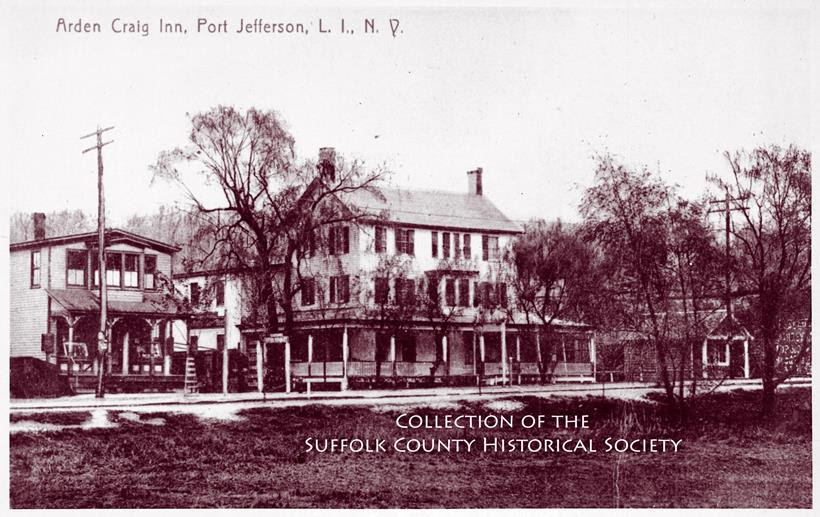
Arden Craig Inn, Port Jefferson. (Image from the Collection of the Suffolk County Historical Society Library Archives. Copyright Suffolk County Historical Society. All rights reserved.)
Thomas Smith erected the original structure in 1870 on what is now the northeast corner of Main Street and Arden Place in the village of Port Jefferson. His daughter Lizzie enlarged the hotel and helped make Lizzie Smith’s Hotel, as it was called at the time, one of the most popular spots in the village.
In 1908, the hotel was purchased by William Thompson, who enlarged it significantly and renamed it the Arden Craig Inn (or Ardencraig Inn). Known for its excellent cuisine and comfortable accommodations, the inn was very popular with yachtsmen visiting the village. The hotel was destroyed by fire in 1920, and was replaced by a series of businesses, including a bowling alley, a car dealership, and a supermarket, among others.
~~~~~~~~~~~~~~~~~~~~~~~~~~~~~~~~~~~~~~~~~~

Exhibit Opening Reception: Join us on Saturday, July 15, 1:00 p.m. , for the opening of a new exhibition, On This Site: The Indigenous People of Suffolk County, an art-based photography exhibit by Shinnecock artist Jeremy Dennis that aims to create awareness of and help preserve culturally significant and sacred Native American sites in Suffolk County. Admission is free to all. Complimentary wine & cheese will be served. On exhibit July 15 – Sept. 30, 2017.
|
Upcoming BOOK & BOTTLE Lectures at SCHS July 27: Jeremy Dennis, Indigenous People of the Twin Forks Call 631-727-2881 x100 to Register!
******************************************
|
PHOTO OF THE WEEK: June 24, 2017 — FROM THE SCHS LIBRARY ARCHIVES
“How shall we know it is us without our past?” – John Steinbeck
The Grucci Family: America’s First Family of Fireworks
by Wendy Polhemus-Annibell, Librarian
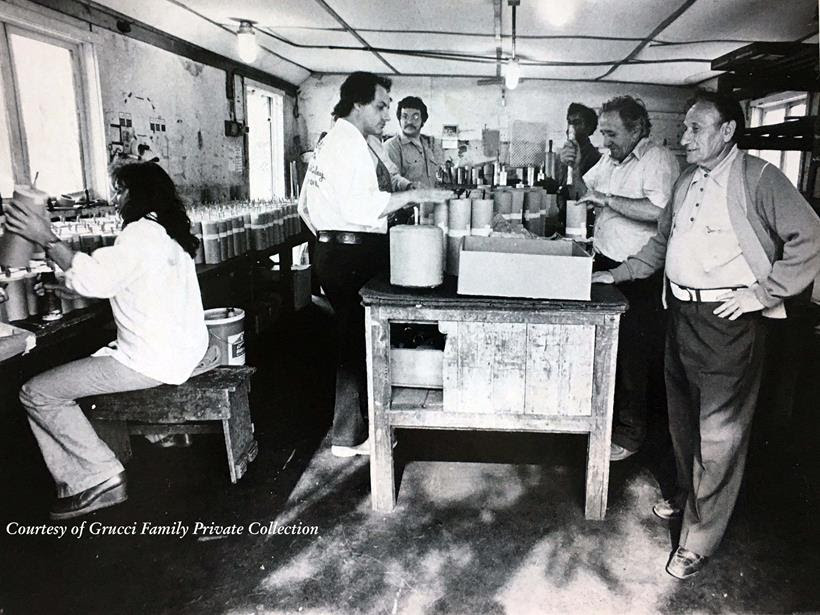
The Grucci Family Making Fireworks, 1975. (Image courtesy of the Grucci Family Private Collection.)
Suffolk County is the proud home and headquarters of America’s First Family of Fireworks. The Grucci family has been lighting the skies on the Fourth of July and for other events and celebrations for six generations. The family traditions began with Angelo Lanzetta in 1850, founder of a small fireworks business in southern Italy. In 1870, Angelo brought his skills to the United States and settled on Long Island. His son Anthony carried on the business, passing the skillset to a nephew, Felix Grucci Sr., who joined the company in 1923. It was Felix Sr. who established the family’s deep roots in Bellport, sustained the business through the Great Depression, and expanded to develop military training ammunition simulators used by the Department of Defense, while also advancing the industry with innovative technologies that set him apart as a master of fireworks art.
Don’t miss our special summer exhibit, Grucci: The Family That Lights the Skies, in our Weathervane Gallery, now through September 9, 2017. Gallery Hours: Wednesday through Saturday, 10:00 am – 4:30 pm.
The Suffolk County Historical Society wishes all of our readers, members, and other supporters a safe and happy Fourth of July holiday.
Holiday Closure: We will be closed on Saturday, July 1, for the holiday weekend, and will reopen on Wednesday, July 5.
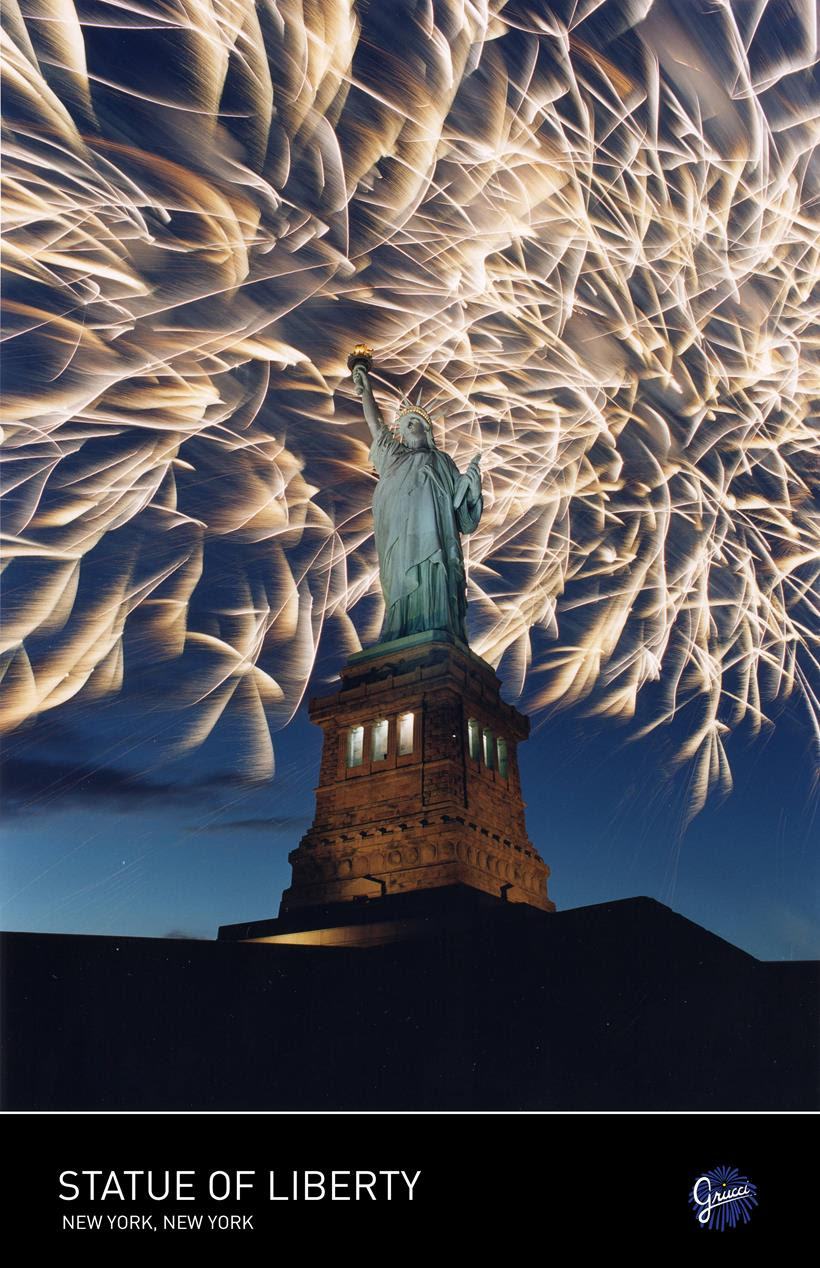
~~~~~~~~~~~~~~~~~~~~~~~~~~~~~~~~~~~~~~~~~~~~~~~~
Upcoming BOOK & BOTTLE Events at SCHS
July 27: Jeremy Dennis, Indigenous People of the Twin Forks
Aug. 24: William Konstant, Recovery of the Bald Eagle
Oct. 7: Bob Giffen, One Little River & Sportsmen’s Club
Nov. 2: Kerriann Brosky, Historic Crimes of Long Island
Call 631-727-2881 x100 to Register!
******************************************
SCHS Photo of the Week: Click Here to Visit Webpage.
Visit: www.suffolkcountyhistoricalsociety.org
To View 2014 Photo of the Week pages click here.
To View 2015 Photo of the Week pages click here.
To View 2016 Photo of the Week pages click here.
_______________________________________________________
PHOTO OF THE WEEK: June 24, 2017 — FROM THE SCHS LIBRARY ARCHIVES
“How shall we know it is us without our past?” – John Steinbeck
Spring 1881 Plant Catalogue
by Wendy Polhemus-Annibell, Librarian

Spring 1881 Plant Catalogue. (Image from the Collection of the Suffolk County Historical Society Library Archives. Copyright © Suffolk County Historical Society. All rights reserved.)
Our library collection includes this Spring 1881 plant catalogue from the Paddock Bro.’s Co. of Cleveland, Ohio, which lists a very wide variety of plants that were available to gardeners of the late nineteenth century. The introduction to the work makes note of the company’s attempt to meet the increasing demand for horticultural products by adding to their facility a new, large propagating house and greenhouse, a large tank with iron turbine wind-engine for their water supply, and a new packing house.
The product catalogue lists an astonishing 115 different varieties of geraniums, 84 types of old garden roses, and a wide assortment of greenhouse and bedding plants. For $1.00 you could buy 12 beautiful roses, for instance, or 12 geraniums, or a combination of 2 roses, 2 fuchsias, 2 heliotropes, 2 geraniums, 2 cupheas, and 2 carnations. Many other combinations were offered. A collection of 375 plants could be had for $19 including express shipping. The company “made no extra charge” for packing, either by mail or Express, and added extra plants for the “Expressage.”
~~~~~~~~~~~~~~~~~~~~~~~~~~~~~~~~
Suffolk County Pine Barrens Exhibit Tours
The Suffolk County Water Authority Education Center will hold special tours of the Suffolk County Pine Barrens Exhibit, on loan from the Suffolk County Historical Society. The educational exhibit provides an overview of the Pine Barrens and the critical role this region plays in the protection of our county’s precious groundwater. The tours will be held on July 20 and August 17, at 12 noon and 1:00 pm, and will also include an interactive water workshop and a fun quiz game for kids. The SCWA Education Center is located at 260 Motor Pkwy in Hauppauge. Call 631-292-6565 or email EdCenterTours@SCWA.com for more information.
******************************************
SCHS Photo of the Week: Click Here to Visit Webpage.
Visit: www.suffolkcountyhistoricalsociety.org
To View 2014 Photo of the Week pages click here.
To View 2015 Photo of the Week pages click here.
To View 2016 Photo of the Week pages click here.
_______________________________________________________
PHOTO OF THE WEEK: June 17, 2017 — FROM THE SCHS LIBRARY ARCHIVES
“How shall we know it is us without our past?” – John Steinbeck
Long Island Strawberry Festival
by Wendy Polhemus-Annibell, Librarian
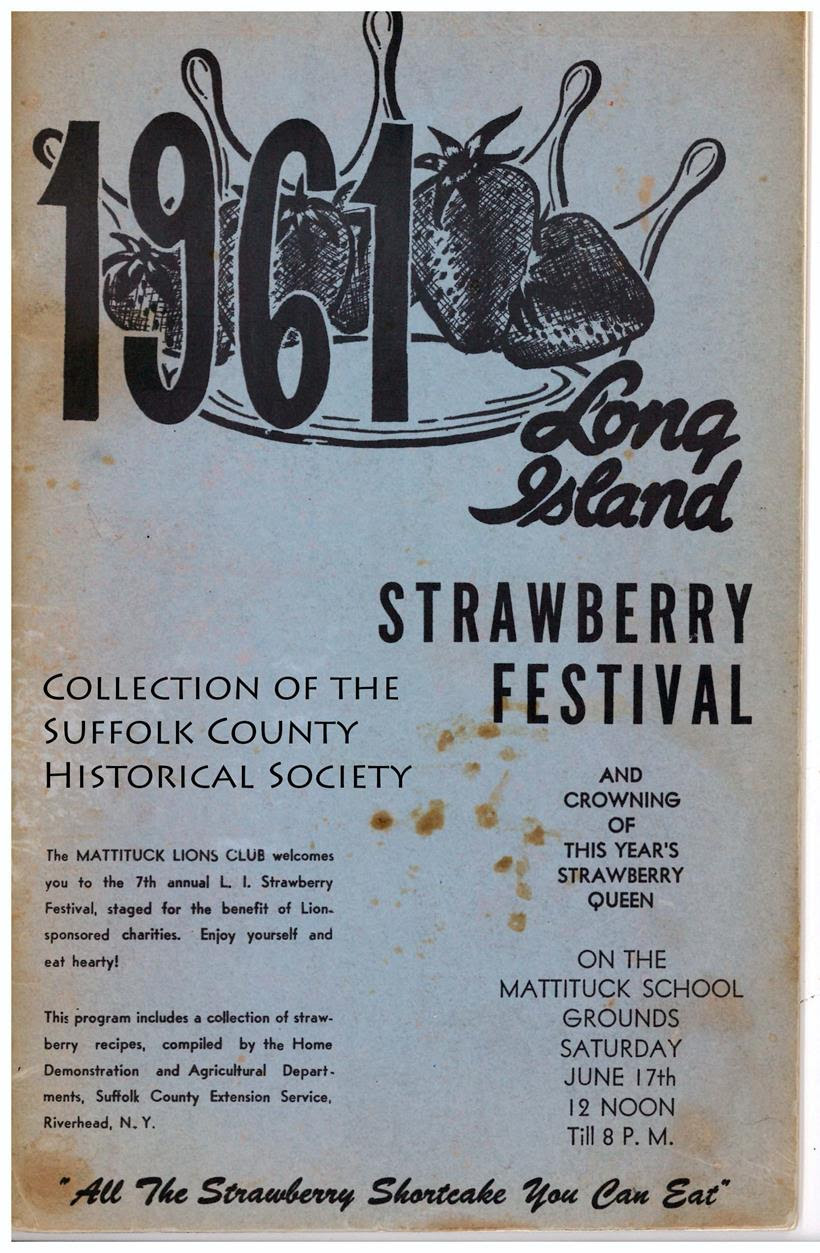
Long Island Strawberry Festival Booklet, Mattituck, 1961. (Image from the Collection of the Suffolk County Historical Society Library Archives.)
With the 63rd Annual Strawberry Festival under way in Mattituck this weekend, we found in our library collection this old program and recipe book that was compiled by the Lions Club for the 1961 festival. The 7th Annual Mattituck Lions Strawberry Festival was held on the grounds of Mattituck High School on Saturday, June 17, 1961. According to the event program, the festivities began at 10:30 a.m. with a parade. Other scheduled events included drawings for berries, a freezing demonstration, the crowning of the Strawberry Queen, a strawberry eating contest, and a drawing for cash awards.
“You can have a strawberry festival ’round the clock serving berries,” the program booklet notes in its introduction to an assortment of strawberry-inspired recipes. “This booklet of recipes has been collected to give you a variety of recipes featuring strawberries, one of Long Island’s important agricultural crops.”
Here’s the 1961 recipe for Shortcake Biscuits:
2 cups flour
3 tsp baking powder
1 Tbsp sugar
1 tsp salt
1/3 cup shortening
1/2 to 2/3 cup milk
1 egg beaten
Sift the dry ingredients. Add the shortening and cut into the dry ingredients with a pastry blender until the mixture has the consistency of cornmeal. Add combined milk and egg, all at once, and stir the mixture with a fork to make a soft dough. Turn the dough onto a lightly floured board and knead gently about 10 times. Roll or pat to 3/4-inch thickness. Cut with a floured biscuit cutter and place on an ungreased baking sheet, 14 x 10 inches. Bake at 425F for about 15 minutes.
~~~~~~~~~~~~~~~~~~~
Suffolk County Pine Barrens Exhibit Tours
The Suffolk County Water Authority Education Center will hold special tours of the Suffolk County Pine Barrens Exhibit, on loan from the Suffolk County Historical Society. The educational exhibit provides an overview of the Pine Barrens and the critical role this region plays in the protection of our county’s precious groundwater. The tours will be held on July 20 and August 17, at 12 noon and 1:00 pm, and will also include an interactive water workshop and a fun quiz game for kids. The SCWA Education Center is located at 260 Motor Pkwy in Hauppauge. Call 631-292-6565 or email EdCenterTours@SCWA.com for more information.
******************************************
SCHS Photo of the Week: Click Here to Visit Webpage.
Visit: www.suffolkcountyhistoricalsociety.org
To view 2014 Photo of the Week pages click here.
To view 2015 Photo of the Week pages click here.
To View 2016 Photo of the Week pages click here.
_______________________________________________________________
PHOTO OF THE WEEK: June 10, 2017 — FROM THE SCHS LIBRARY ARCHIVES
“How shall we know it is us without our past?” – John Steinbeck
Suffolk County Fair Auto Races, Riverhead, 1920
by Wendy Polhemus-Annibell, Librarian
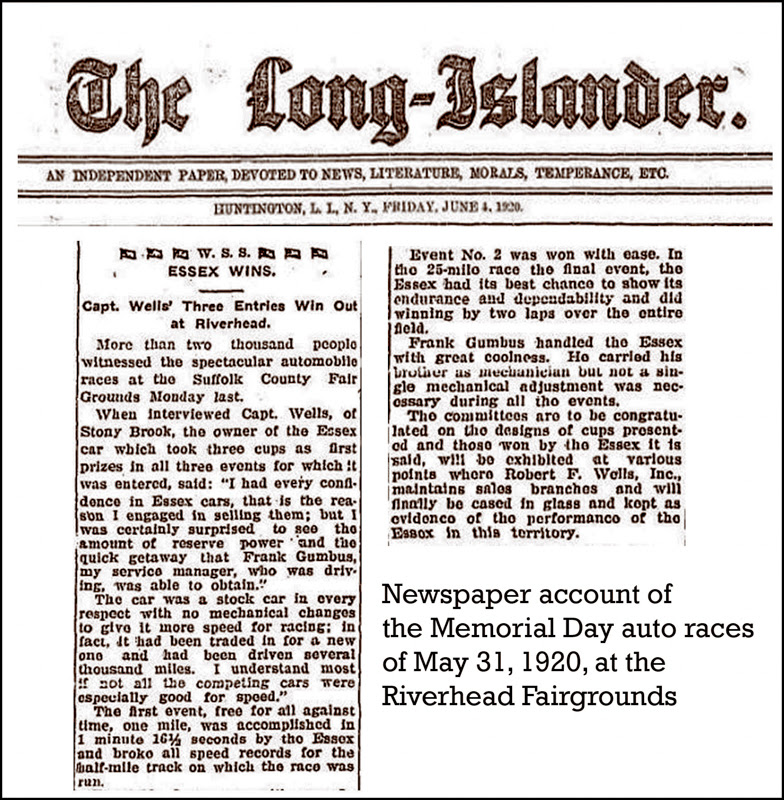
Suffolk County Fair Auto Races, Riverhead, 1920. More than two thousand people attended the automobile races at the Riverhead Fairgrounds on May 31, 1920. Capt. Robert F. Wells of Stony Brook, owner of the Essex, took first prizes in all three races of the day, according to a report in The Long Islander. The first event was a one-mile race on a half-mile track, which the Essex completed in 76.5 seconds, breaking all speed records at the time. In the second event, a 25-mile race, the Essex won by two laps over the entire field (the actual First Prize cup is shown below). Capt. Wells, an auto dealer of the Essex, noted his confidence in the vehicle, but was “surprised to see the amount of reserve power and quick getaway” it could obtain in the race. His service manager, Frank Gumbus, was said to have handled the Essex in the Riverhead races “with great coolness.”
According to local automotive historian Bob Barauskas, it’s unclear which Essex model participated in the 1920 race. For that model year, there were four Essex models available: a two-door Roadster, a four-door Touring Car, a four-door Sedan, and a two-door Cabriolet. The Essex Motor Company of Detroit, Michigan, began with the Hudson Motor Company. Initially, the company had its own sponsoring organization, the Essex Motor Company, which first leased a factory in Detroit in 1917 to build the affordable car. By 1918, the company had built ninety-two Essex cars (as 1919 models), and by 1922, both Essex and Hudson were being manufactured under the Hudson Motor Car Company. More than 1.13 million Essex automobiles were sold by the time the Essex name was retired in 1932.
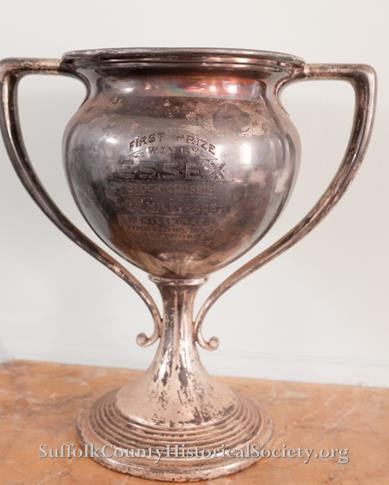
~~~~~~~~~~~~~~~~~~~~~~~~~
Upcoming BOOK & BOTTLE Events at SCHS
June 22: Kevin Fitzpatrick, Camp Upton Centennial
July 27: Jeremy Dennis, Indigenous People of the Twin Forks
Aug. 24: William Konstant, Recovery of the Bald Eagle
Oct. 7: Bob Giffen, One Little River & Sportsmen’s Club
Nov. 2: Kerriann Brosky, Historic Crimes of Long Island
******************************************
SCHS Photo of the Week: Click Here to Visit Webpage.
Visit: www.suffolkcountyhistoricalsociety.org
To view 2014 Photo of the Week pages click here.
To view 2015 Photo of the Week pages click here.
To View 2016 Photo of the Week pages click here.
_______________________________________________________________
PHOTO OF THE WEEK: June 3, 2017 — FROM THE SCHS LIBRARY ARCHIVES
“How shall we know it is us without our past?” – John Steinbeck
First Settlement of Long Island
by Wendy Polhemus-Annibell, Librarian
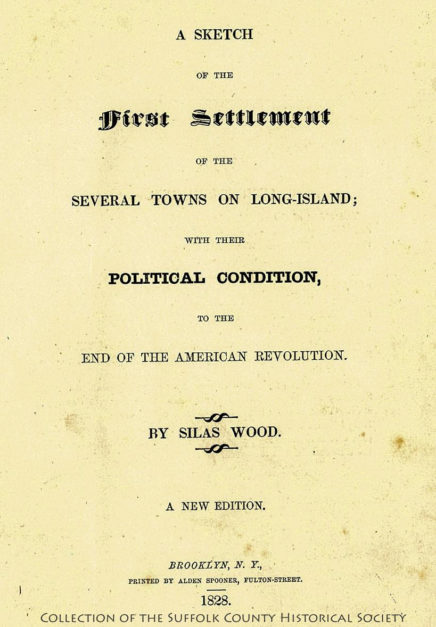
Silas Wood (1769-1847). Historian Silas Wood, author of the first history of Long Island, A Sketch of the First Settlement of the Several Towns on Long-Island, was born in West Hills, Huntington, in 1769. He attended Princeton College, where he pursued a course of classical studies and graduated with honors. At age 22, in 1795, Silas was elected to the New York State Assembly. He served there for four years, and introduced bills for the formation of social libraries and for the state Highway Act.
In 1817, Silas Wood was elected by the people of the 1st Congressional District of Suffolk County as their representative in Congress. He retained his congressional seat for five consecutive terms, from 1819 to 1829, during the 16th to 20th Congresses. During most of his time in Congress, Rep. Wood served on the Library Committee, which suited him well given his love and knowledge of books and literature. He also served as Suffolk County District Attorney (1818-1821).
Wood’s A Sketch of the First Settlement of the Several Towns on Long-Island; with Their Political Condition, to the End of the American Revolution (Brooklyn: Alden Spooner) was published in three editions: the first in 1824 in 66 pages, the second in 1826 in 112 pages, and the third in 1828 in 183 pages. Silas Wood is buried in the Old Public Cemetery in Huntington.
******************************************
SCHS Photo of the Week: Click Here to Visit Webpage.
Visit: www.suffolkcountyhistoricalsociety.org
To view 2014 Photo of the Week pages click here.
To view 2015 Photo of the Week pages click here.
To View 2016 Photo of the Week pages click here.
_______________________________________________________________
PHOTO OF THE WEEK: May 26, 2017 — FROM THE SCHS LIBRARY ARCHIVES
“How shall we know it is us without our past?” – John Steinbeck
Brindley Aviation Field, 1918 – 1919
by Wendy Polhemus-Annibell, Librarian

Brindley Aviation Field, Commack, 1918-1919. On the northeast corner of Larkfield Road and Jericho Turnpike in Commack stands the Home Depot shopping center. However, during World War I, from 1918 to 1919, the site was known as Brindley Field and was home to a squadron of the U.S. Army Air Service.
The airfield, named after Major Oscar Brindley who had died in an aircraft accident in Ohio, occupied nearly a hundred acres of land owned by local farmer William Randall. His home was turned into a headquarters, and the outer buildings were used for storage. Constructed on the property were the flying field, barracks, mess halls, and hangers.
The arrival of Brindley Field brought electricity to the area since the airfield needed power lines to operate. When Brindley was closed after World War I ended, the site was returned to its landowner and the military buildings were destroyed or removed.
The Suffolk County Historical Society wishes veterans and their families a happy Memorial Day holiday.
******************************************
SCHS Photo of the Week: Click Here to Visit Webpage.
Visit: www.suffolkcountyhistoricalsociety.org
To view 2014 Photo of the Week pages click here.
To view 2015 Photo of the Week pages click here.
To View 2016 Photo of the Week pages click here.
_______________________________________________________________
PHOTO OF THE WEEK: May 20, 2017 — FROM THE SCHS LIBRARY ARCHIVES
“How shall we know it is us without our past?” – John Steinbeck
250th Anniversary of Suffolk County, Riverhead, 1933
by Wendy Polhemus-Annibell, Librarian
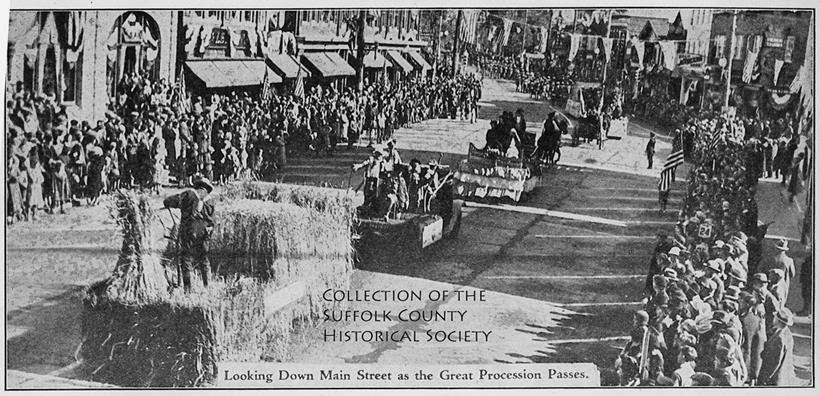
250th Anniversary of Suffolk County, Riverhead, 1933. (Image from the Collection of the Suffolk County Historical Society Library Archives. Copyright © Suffolk County Historical Society. All rights reserved.)
In 1933, with almost 18,000 people in attendance for the parade and pageant in downtown Riverhead, the 250th anniversary of the founding of Suffolk County was successful beyond all expectations. The preparations were made by the anniversary committee, headed by former Suffolk County District Attorney George W. Hildreth as chairman, and included a great parade in which all ten towns of the county were represented by elaborately decorated floats. Uniformed military and volunteer firemen, school bands, town officials, Boy and Girl Scouts, and the Suffolk County Historical Society, among others, also participated in the anniversary parade. Marching tunes were played by 14 bands, and 40 fire departments were represented by their members and fire trucks. An old horse-drawn, steam-driven pumper of the Riverhead Fire Dept. occupied a place of honor as it was pulled through the streets, whistle shrieking and black smoke belching from its stack.
The judging committee awarded beautiful silver cups for outstanding floats and other parade entries in various topical categories. Awards for floats that depicted events of historical significance, for instance, went to the Shelter Island Community Club for its Sylvester sisters float, to the United Polish Society of Riverhead for its “Landing of the Puritan Settlers,” and to Congressman Robert Bacon for a “Smithtown Bull Rider” float. Honorable mentions went to Southold for “The First Court House” float and to the Long Island Lighting Company for its portrayal of the signing of the Declaration of Independence. Awards for fire departments went to Westhampton Beach Fire Dept. for the most men in line and to Huntington Fire Dept. for most apparatus in line. Southampton won an award for having the largest town representation in the parade.
Suggested Reading: 250th Anniversary of Suffolk County, 1683-1933, Celebration at Riverhead, New York, Souvenir Program, 1933.
******************************************
SCHS Photo of the Week: Click Here to Visit Webpage.
Visit: www.suffolkcountyhistoricalsociety.org
To view 2014 Photo of the Week pages click here.
To view 2015 Photo of the Week pages click here.
To View 2016 Photo of the Week pages click here.
_______________________________________________________________
PHOTO OF THE WEEK: May 13, 2017 — FROM THE SCHS LIBRARY ARCHIVES
“How shall we know it is us without our past?” – John Steinbeck
American Mother’s Day
by Wendy Polhemus-Annibell, Librarian
A Brief History of the American Mother’s Day. (Image from the Postcard Collection of the Suffolk County Historical Society Library Archives. Copyright © Suffolk County Historical Society. All rights reserved.)
Mother’s Day, a holiday honoring motherhood, is observed in different forms throughout the world. In the United States, Mother’s Day is celebrated by presenting mothers and other women with gifts and flowers, and it has become one of the biggest holidays for consumer spending.
The American Mother’s Day was founded by Anna Jarvis in 1908 and became an official U.S. holiday in 1914. However, the origins of Mother’s Day in the United States date back to the nineteenth century. In the years before the Civil War, Anna’s mother, Ann Reeves Jarvis of West Virginia, helped start “Mothers’ Day Work Clubs” to teach local women how to properly care for their children. These clubs later became a unifying force in a region of the country still divided over the Civil War. In 1868, Jarvis organized “Mothers Friendship Day,” when mothers gathered with former Union and Confederate soldiers to promote reconciliation.
Another precursor to Mother’s Day came from the abolitionist and suffragist Julia Ward Howe. In 1870 Howe wrote the “Mother’s Day Proclamation,” a call to action that asked mothers to unite in promoting world peace. At times in the 20th century, Mother’s Day has also been a date for launching social causes. In 1968, Coretta Scott King, wife of Martin Luther King Jr., used Mother’s Day to host a march in support of underprivileged women and children. In the 1970s, women’s groups used the holiday as a time to highlight the need for equal rights and access to childcare.
The Suffolk County Historical Society
wishes all of our members, friends, and supporters
a very happy Mother’s Day!
******************************************
SCHS Photo of the Week: Click Here to Visit Webpage.
Visit: www.suffolkcountyhistoricalsociety.org
To view 2014 Photo of the Week pages click here.
To view 2015 Photo of the Week pages click here.
To View 2016 Photo of the Week pages click here.
_______________________________________________________________
PHOTO OF THE WEEK: May 6, 2017 — FROM THE SCHS LIBRARY ARCHIVES
“How shall we know it is us without our past?” – John Steinbeck
Aquebogue Congregational Church
by Wendy Polhemus-Annibell, Librarian

Aquebogue Congregational Church. (Image from the Postcard Collection of the Suffolk County Historical Society Library Archives. Copyright © Suffolk County Historical Society. All rights reserved.)
The Old Steeple Church in Upper Aquebogue was organized in 1768 with just 16 members (11 women and 5 men): Nathaniel Wells, Jonathan Reeve, Deborah Corwin, Richard Howell, Timothy Wells, Anna Moore, Prudence Luce, Hannah Herre, Mary Wells, Eleazer Luce, Mary Wells, Anna Youngs, Mary Youngs, Abiah Sweezy, Sarah Howell, and Abiah Luce.
The original church building was located within the cemetery across the street from the current church structure, offering a convenient way for people coming to church by boat from Riverhead, Flanders, Jamesport, and other locations along Peconic Bay. Many others came to church on horseback or in box wagons drawn by oxen. Most people walked.
Timothy Wells, grandson of Justice Joshua Wells of Southold, was the first pastor of the church. The second minister of the church was Rev. Daniel Youngs. His ministry lasted 32 years, from 1782 to 1814. Rev. Youngs was the great grandson of Southold’s founder, Rev. John Youngs.
The current church building located on the north side of Main Road, was built in the 1860s. A note in the diary of George Henry Tuthill notes: “July 8, 1862. Began building a new church at Upper Aquebogue.” The first couple married in the new church was J. Madison Wells and Catherine Terry in 1863. During the 1938 hurricane, the church steeple was blown down, and funds were raised to construct a new one, which was dedicated in 1939.
Suggested Readings: A History of the Congregational Church in Aquebogue, by Rev. William I. Chalmers, 1910; “A History of Aquebogue Church Buildings,” by Roswell Corwin, 1963
******************************************
SCHS Photo of the Week: Click Here to Visit Webpage.
Visit: www.suffolkcountyhistoricalsociety.org
To view 2014 Photo of the Week pages click here.
To view 2015 Photo of the Week pages click here.
To View 2016 Photo of the Week pages click here.
_______________________________________________________________
PHOTO OF THE WEEK: April 29, 2017 — FROM THE SCHS LIBRARY ARCHIVES
“How shall we know it is us without our past?” – John Steinbeck
U.S. Army Ambulance Service, 1917
by Wendy Polhemus-Annibell, Librarian
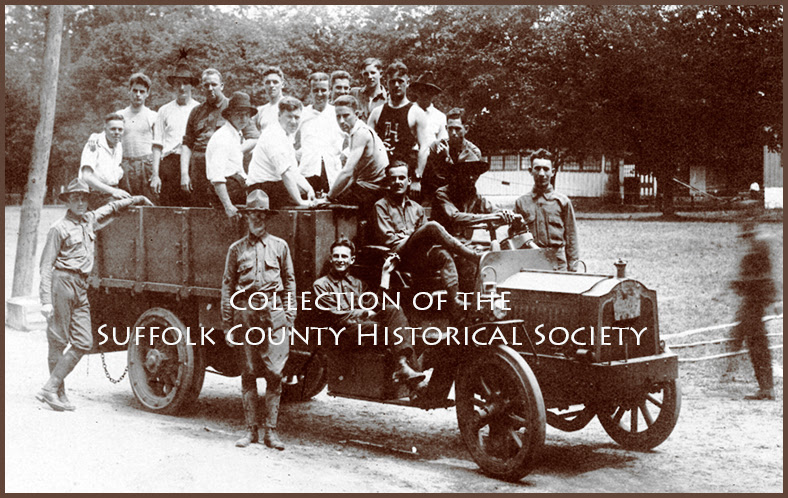
U.S. Army Ambulance Service, 1917. Daniel Tuthill (1897-1958) of Jamesport (back row, third from left) served with the Ambulance Service during World War I; he was also the first soldier from Suffolk County to receive the French War Cross. (Image from the World War One Pictorial Collection of the Suffolk County Historical Society Library Archives. Copyright © Suffolk County Historical Society. All rights reserved.)
In April 1917, the United States entered World War I on the side of the Allies (France, Russia, Great Britain, and Italy). The British and French asked for immediate medical support because their medical systems were severely taxed. To meet the needs of war, the U.S. Army’s surgeon general, William M. Gorgas, presided over an enormous expansion of the Army Medical Department. When the United States entered the war, the department consisted of about a thousand personnel, but it numbered over 350,000 when peace returned in November 1918. The Surgeon General’s Office mushroomed from a staff of 153 at the beginning of the war to over 2,100 at its end. The Medical Department was authorized 444 physicians at the beginning of World War I, and had 31,530 when the war ended. Nearly 24 percent of all U.S. physicians served in the Army. Increases in the other specialties were also dramatic. By war’s end the department had 4,620 dentists, 21,480 nurses, and 2,234 veterinarians.
In addition, there were two new precursors of the Medical Service Corps. The U.S. Army Ambulance Service, formed in 1917, had 209 officers, and the Sanitary Corps formed the same year, had 2,919. The department was rounded out with 281,341 enlisted soldiers and 10,695 civilian employees.
Join us today — April 29th — for the opening of our Centennial World War I exhibit, “Over Here, Over There: Long Island and the Great War,” at 1:00 pm to 3:00 pm. Admission is free, and light refreshments will be served. Arrive on time to see our historical WWI reenactors!
This exhibit will run to January 2018. Exhibit admission is free for all U.S. veterans from April 29 to May 26, 2017.

************************************************************ |
SCHS Photo of the Week: Click Here to Visit Webpage.
Visit: www.suffolkcountyhistoricalsociety.org
To view 2014 Photo of the Week pages click here.
To view 2015 Photo of the Week pages click here.
To View 2016 Photo of the Week pages click here.
~~~~~~~~~~~~~~~~~~~~~~~~~~~~~~~~~~~~~~~
PHOTO OF THE WEEK: April 22, 2017 — FROM THE SCHS LIBRARY ARCHIVES
“How shall we know it is us without our past?” – John Steinbeck
Long Island’s Tercentenary–1936
by Wendy Polhemus-Annibell, Librarian
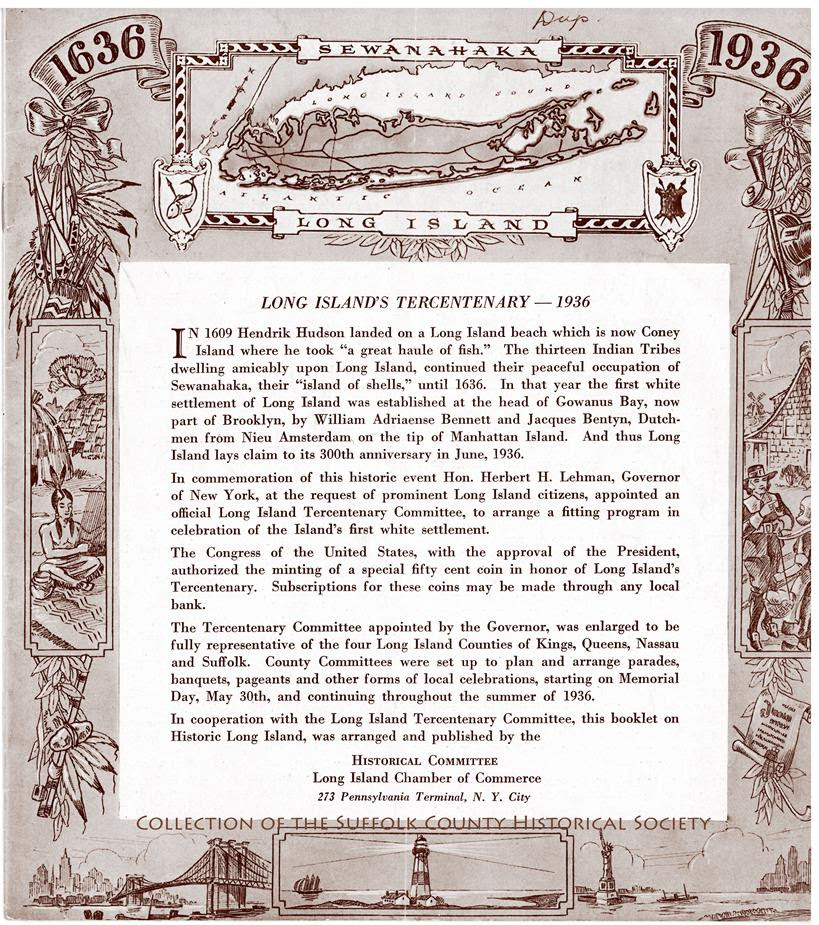
Long Island’s Tercentenary, 1936. (Image from the Collection of the Suffolk County Historical Society Library Archives.)
The first European settlement of Long Island (named Lange Eylant by the Dutch) was established at the head of Gowanus Bay, Brooklyn, in 1636, by William Adriaense Bennett and Jacques Bentyn, Dutchmen from New Amsterdam (on the tip of Manhattan Island). Thus, Long Island made claim to its 300th anniversary in 1936.
In commemoration of this historic event, New York Governor Herbert H. Lehman appointed a Long Island Tercentenary Committee to arrange a program in celebration. The U.S. Congress, with the approval of the President, authorized the minting of a special 50-cent coin in honor of Long Island’s Tercentenary. The committee was enlarged to be fully representative of the four Long Island Counties of Kings, Queens, Nassau, and Suffolk. County Committees were set up to plan and arrange parades, banquets, pageants, and other forms of local celebrations, beginning on Memorial Day and continuing throughout the summer of 1936. In cooperation with the Long Island Tercentenary Committee, this booklet on “Historic Long Island” was published by the Historical Committee of the Long Island Chamber of Commerce. The booklet is available for reference in our research library.
************************************************************
SCHS Photo of the Week: Click Here to Visit Webpage.
Visit: www.suffolkcountyhistoricalsociety.org
To view 2014 Photo of the Week pages click here.
To view 2015 Photo of the Week pages click here.
To View 2016 Photo of the Week pages click here.
~~~~~~~~~~~~~~~~~~~~~~~~~~~~~~~~~~~~~~~
PHOTO OF THE WEEK: April 15, 2017 — FROM THE SCHS LIBRARY ARCHIVES
“How shall we know it is us without our past?” – John Steinbeck
Flanders, Town of Southampton
by Wendy Polhemus-Annibell, Librarian
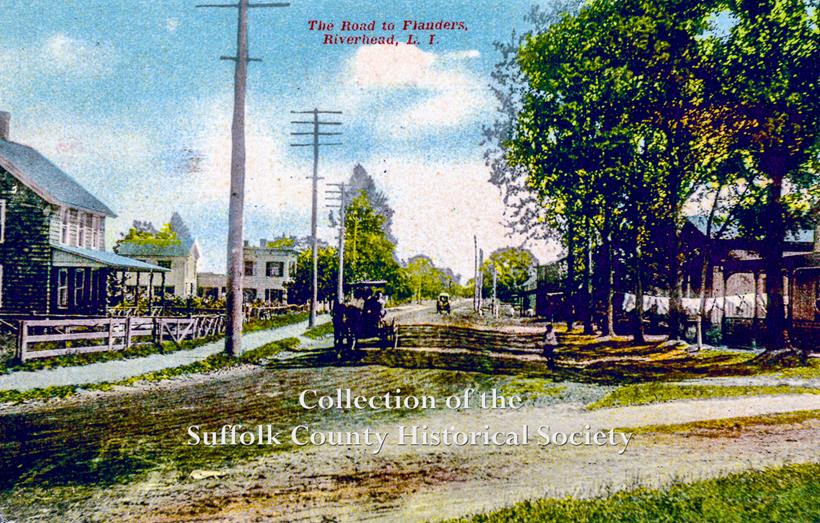
The Road to Flanders, c. 1910. (Image from the Postcard Collection of the Suffolk County Historical Society Library Archives.)
How and when Flanders acquired its present-day name remain a mystery, though it may be that the hamlet adopted the name based on its wetlands and other similarities with the Flanders region of present-day Belgium in Europe. The word “Flanders” is adopted from the Flemish “Vlaanderen,” which means “flooded land.”
It’s believed that Josiah Goodale was the earliest Englishman to permanently settle in the area that would become known as Flanders. Southampton Town records refer to his house at “Aukabog” as early as 1761, and other references indicate that it was likely built prior to 1760. Josiah is credited with clearing much of the land in the hamlet area, and his descendants continue to reside there today. Another early inhabitant was James Fanning II, a Southold native and son of Captain James Fanning, who was a hero of the French Indian War and the first of the Fannings to settle on Long Island. The oldest known surviving house in the hamlet is that of James Benjamin. His homestead, built in circa 1782 and located on Flanders Road, is listed on the National Register of Historic Places.
To read much more about the history of Flanders, see the Flanders Hamlet Heritage Area Report (2014).
———————————–
The Suffolk County Historical Society is preparing a major exhibit to commemorate the Centennial of World War I. An opening reception will be held on Saturday, April 29, at 1:00 pm, in our Grand Staas Gallery. All are welcome. Admission is free, and light refreshments will be served. Curated by Richard F. Welch, Over Here, Over There: Long Island & the Great Warwill feature artifacts, maps, photographs, weaponry, posters, and more depicting Long Islanders’ experiences during the war…from the front lines to the home front, neutrality to belligerence, and mobilization to victory. We hope you can join us for this special event!
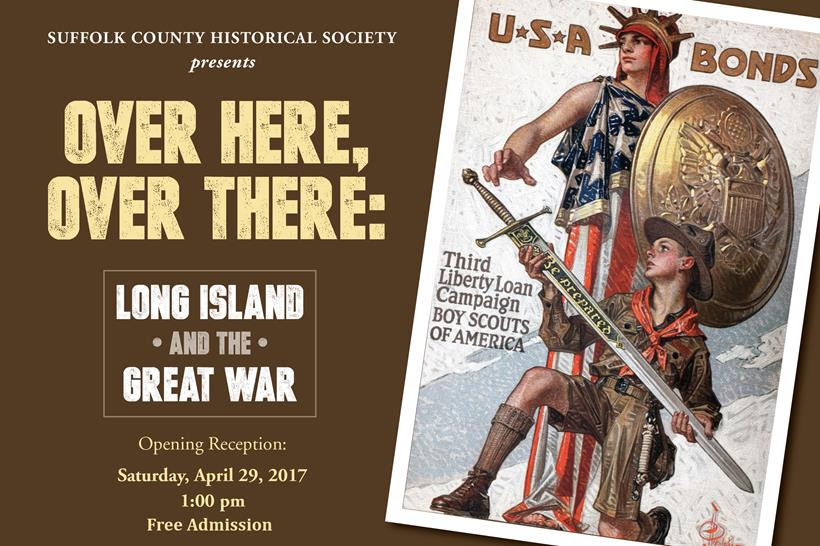
************************************************************
SCHS Photo of the Week: Click Here to Visit Webpage.
Visit: www.suffolkcountyhistoricalsociety.org
To view 2014 Photo of the Week pages click here.
To view 2015 Photo of the Week pages click here.
To View 2016 Photo of the Week pages click here.
~~~~~~~~~~~~~~~~~~~~~~~~~~~~~~~~~~~~~~~
PHOTO OF THE WEEK: April 8, 2017 — FROM THE SCHS LIBRARY ARCHIVES
“How shall we know it is us without our past?” – John Steinbeck
77th Division at Camp Upton
by Wendy Polhemus-Annibell, Librarian

World War I Centennial: The 77th Division at Camp Upton (Images from the Postcard Collection of the Suffolk County Historical Society Library Archives.)
On April 6, 1917, a hundred years ago almost to the day, the United States formally declared war against Germany and joined the Allied efforts in the First World War, making 1917 one of the most significant years of the twentieth century in redefining the world order. In the spring of 1917, New York state ordered a military census to secure “certain information from the men and women of the State between the ages of 16 and 50 years…[to ensure] the population shall be completely mobilized for war” (see the 1917 “Instructions for Census Agents“).
Draftee Divisions, the 76th through the 93rd, were designated as the National Army. New camps were built to accommodate and train the divisions, one of the largest of them being Camp Upton (today the site of Brookhaven National Lab). But in May 1917, this part of Suffolk County between Calverton and Middle Island was nothing more than a vast stretch of wilderness, scrub oak, and scrub pine. Through the combined efforts of Army men and volunteers, the land was cleared and barracks were erected, enough to accommodate 40,000 troops. By September 1917, Camp Upton would receive its first allotment of draftees from New York City and the surrounding area.
The largest number of troops trained at Camp Upton were the New York draftees known as the 77th Division (bottom postcard image). The first contingent of the 77th left Camp Upton for France in March 1918; under the leadership of General Evan Johnson, the 77th would gain national recognition for its valor at the Argonne Forest in August of that same year. Among the members of the 77th Division was Sergeant Irving Berlin, who while at Camp Upton wrote the military musical “Yip, Yip Yaphank.” A Broadway production would follow with Berlin’s fellow soldiers filling the cast.
————————————-
WORLD WAR 1 CENTENNIAL EXHIBIT
The Suffolk County Historical Society is preparing a World War I Centennial Exhibit with an opening reception on Saturday, April 29, at 1:00 pm, in our Grand Staas Gallery. All are welcome. Admission is free, and light refreshments will be served. Curated by Richard F. Welch, Over Here, Over There: Long Island & the Great War will feature artifacts, maps, photographs, weaponry, posters, and more depicting Long Islanders’ experiences during the war . . . from the front lines to the home front, neutrality to belligerence, and mobilization to victory.
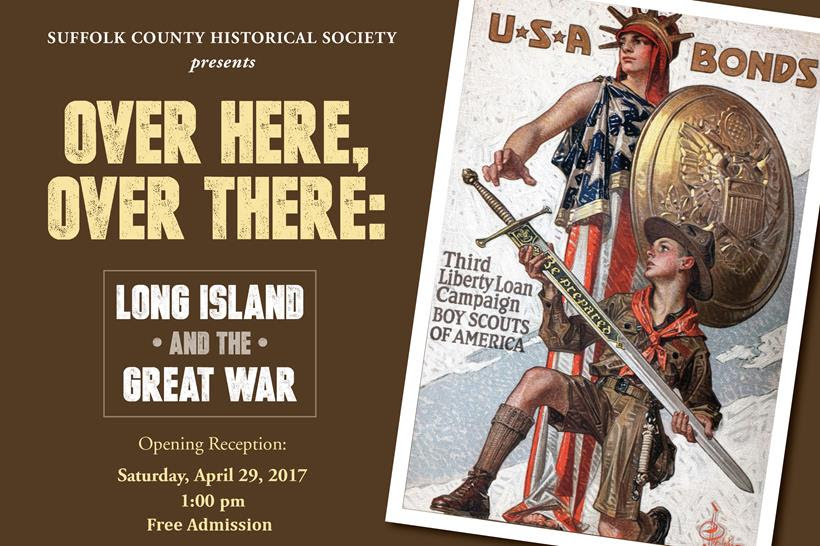
************************************************************
SCHS Photo of the Week: Click Here to Visit Webpage.
Visit: www.suffolkcountyhistoricalsociety.org
To view 2014 Photo of the Week pages click here.
To view 2015 Photo of the Week pages click here.
To View 2016 Photo of the Week pages click here.
~~~~~~~~~~~~~~~~~~~~~~~~~~~~~~~~~~~~~~~
PHOTO OF THE WEEK: April 1, 2017 — FROM THE SCHS LIBRARY ARCHIVES
“How shall we know it is us without our past?” – John Steinbeck
Granny Road, Farmingville to Yaphank
by Wendy Polhemus-Annibell, Librarian

Granny Road (From the 1909 Belcher Hyde Map Collection of the Suffolk County Historical Society Library Archives.)
Granny Road is a very old road that runs from Farmingville to Yaphank. Have you ever wondered why it’s called Granny Road?
According to local lore, the road is named after Esther Dickinson Penny, known as “Granny Penny.” She was a midwife or doctress, delivering babies, fixing broken bones, and making her own medicines. It was a common sight to see Granny Penny in a red cloak riding a white horse down the road to help a neighbor, or so the legend goes:
Let’s just imagine you were walking along the road that led from Farmingville to the fuller’s mill at Yaphank in 1799, and you heard the clatter of hoofs behind you. Then you saw a white horse go thundering by, urged on by a woman in a red camelot coat. You would know, as you do today when the fire siren stops you short, that there had been an accident and Granny was rushing to the scene of it.
Born in circa 1735, Esther first married a Mr. Case, who reportedly just “disappeared”; she then married Jonah Halsey of Southold and had two children, Jonah Jr. and Phoebe. Sometime after her second husband died, Granny married a Penny. Years later, a widow for the third time, Granny went to live at her daughter’s home in Wading River (Pheobe had married Jonah Hulse). Granny Penny remained there, at the old Hulse house, until 1837, when she died at the age of 103.
Suggested Reading: “The Granny Road,” Long Island Forum, 1971.
—————————————
The Suffolk County Historical Society is in search of photographs and other memorabilia of Babe Ruth’s historic baseball game at the Riverhead Fairgrounds. Please call 631-727-2881 x100 if you can help!
Read about the game here.
************************************************************
SCHS Photo of the Week: Click Here to Visit Webpage.
Visit: www.suffolkcountyhistoricalsociety.org
To view 2014 Photo of the Week pages click here.
To view 2015 Photo of the Week pages click here.
To View 2016 Photo of the Week pages click here.
~~~~~~~~~~~~~~~~~~~~~~~~~~~~~~~~~~~~~~~
PHOTO OF THE WEEK: March 25, 2017 — FROM THE SCHS LIBRARY ARCHIVES
“How shall we know it is us without our past?” – John Steinbeck
Babe Ruth in Riverhead, November 9, 1923
by Wendy Polhemus-Annibell, Librarian
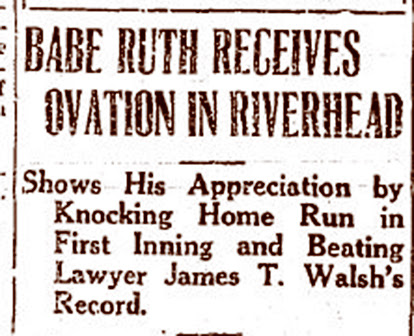
Babe Ruth Plays Baseball at Riverhead Fairgrounds, November 1923. (From the Newspaper Collection of the Suffolk County Historical Society Library Archives.)
As reported in the Riverhead News and County Review in November 1923, George Herman “Babe” Ruth, along with Jack Scott of World Series fame and a selection of All-Star players, defeated the Suffolk All-Stars 5 to 3 at a baseball game held at the Riverhead Fairgrounds on the afternoon of Friday, November 9, 1923. Babe Ruth lived up to his reputation as the “King of Swat,” slamming a home run in the first inning. The ball traveled over the grandstand and bounced back onto the racetrack. As Babe trotted around the bases with a long-distance stride, the crowd went wild with joy. Many of the fans in attendance had never before seen Babe Ruth play a baseball game.
Jack Scott of the Giants pitched a “clever” game through the nine innings. He was opposed on the mound by Suffolk All-Star Harold Goldsmith, who pitched seven innings before being replaced by Jack Conroy of Huntington. Other Suffolk All-Star players included Leo Mitchell, the only Riverhead player on the team; Johnny Brush of Huntington; Al Salmon of Southold; Joe Cassidy and Ray Heany of Greenport; and Walgo of Mattituck, the “Home Run King” of the Eastern Long Island League. Walgo made two extraordinary catches of Babe Ruth’s drives into the outer field.
Upon his arrival at the Fairgrounds, Babe Ruth received a great ovation from the crowd, who surrounded his big Packard. His visit was considered such an important event that all school classes in Riverhead were dismissed to allow students and teachers to attend the game.
The Suffolk County Historical Society is in search of photographs and other memorabilia of Babe Ruth’s historic baseball game at the Riverhead Fairgrounds. Please call 631-727-2881 x100 if you can help!
************************************************************
SCHS Photo of the Week: Click Here to Visit Webpage.
Visit: www.suffolkcountyhistoricalsociety.org
To view 2014 Photo of the Week pages click here.
To view 2015 Photo of the Week pages click here.
To View 2016 Photo of the Week pages click here.
~~~~~~~~~~~~~~~~~~~~~~~~~~~~~~~~~~~~~~~
PHOTO OF THE WEEK: March 18, 2017 — FROM THE SCHS LIBRARY ARCHIVES
“How shall we know it is us without our past?” – John Steinbeck
New York Suffrage Amendment 1
by Wendy Polhemus-Annibell, Librarian
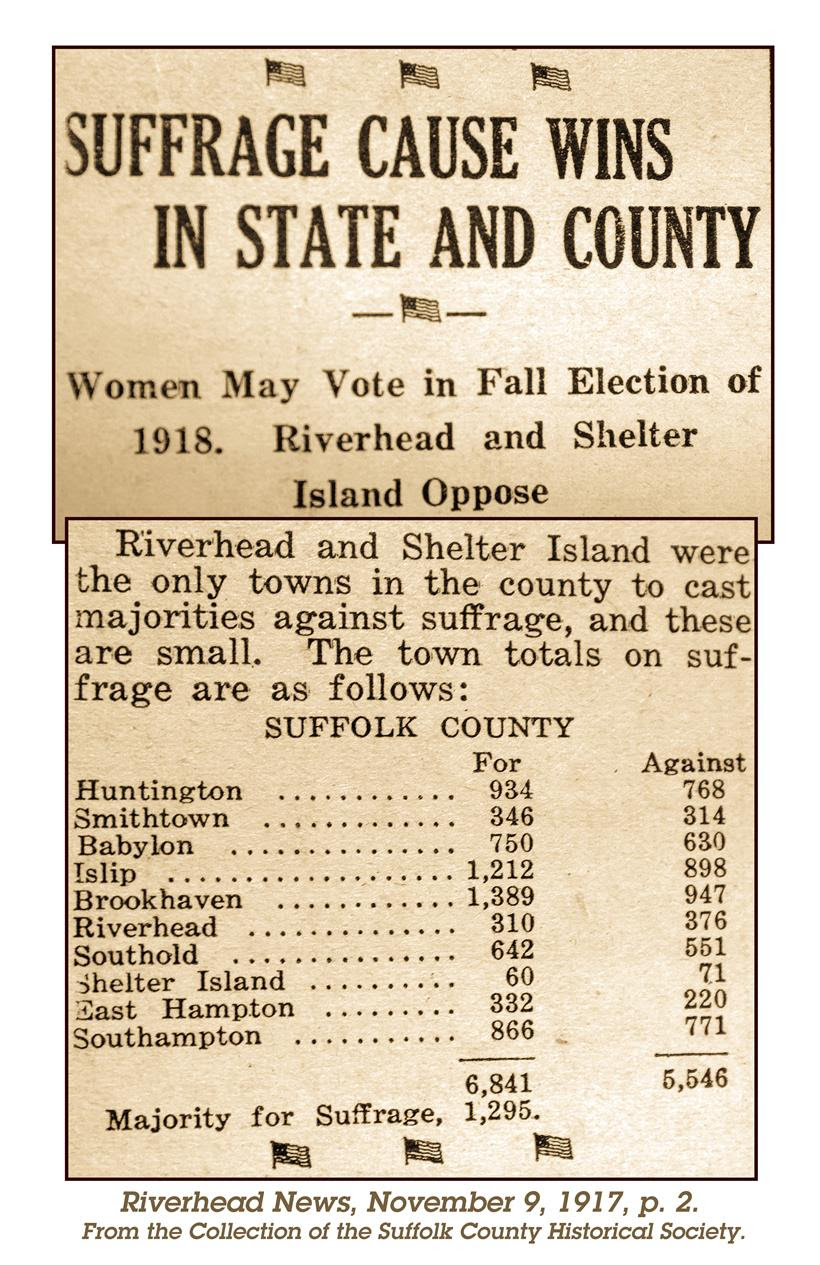
New York Suffrage Vote Totals in Suffolk County, November 6, 2017
. (From the Newspaper Collection of the Suffolk County Historical Society Library Archives.)
~~~~~~~~~~~~~~~~~~~~~~~~~~~~~
Suffrage (noun): the right to vote in political elections.
In 1917, after seven decades of New York women and their male allies fighting the suffrage battle, a referendum was put up for a vote in New York state. The legislatively referred constitutional amendment was known as New York Suffrage Amendment 1 or Proposed Amendment 1. The vote took place on November 6, 1917, and was approved by male voters by a margin of 53.92% to 46.08% statewide.
In Suffolk County, Riverhead and Shelter Island were the only towns to cast majority votes against the suffrage, amendment, while the other eight towns–Southold, East Hampton, Southampton, Brookhaven, Islip, Smithtown, Huntington, and Babylon–all voted in favor of granting New York women the right to vote. Three more years would pass before the nation followed suit in 1920.

100 Years: Votes for New York Women, a Centennial Exhibit Celebrating Long Island Women’s Role in New York’s 1917 Suffrage Victory. On display March 11 to end of year. Curated by Wendy Polhemus-Annibell. Gallery Hours: Weds. – Sat., 10:00 am – 4:30 pm. When New York State women won the right to vote one hundred years ago—making 2017 the centennial of that historic civil rights victory—their success changed the national political landscape and was a critical tipping point on the road to a constitutional amendment. Our “History in the Hall” exhibit celebrates the centennial by narrating the stories of Long Island women activists who dedicated themselves to the powerful grassroots movement.
************************************************************
SCHS Photo of the Week: Click Here to Visit Webpage.
Visit: www.suffolkcountyhistoricalsociety.org
To view 2014 Photo of the Week pages click here.
To view 2015 Photo of the Week pages click here.
To View 2016 Photo of the Week pages click here.
~~~~~~~~~~~~~~~~~~~~~~~~~~~~~~~~~~~~~~~
PHOTO OF THE WEEK: March 11, 2017 — FROM THE SCHS LIBRARY ARCHIVES
“How shall we know it is us without our past?” – John Steinbeck
Elisabeth Freeman, Kings Park
by Wendy Polhemus-Annibell, Librarian

Elisabeth Freeman (1876-1942) of Kings Park (upper left photo, and with Rosalie Jones). (Images courtesy of the Library of Congress).
Elisabeth Freeman, born in England, came to the United States as a child with her brother, sister, and mother, Mary Hall Freeman, who was estranged from her husband. Mary worked at St. Johnland, an orphanage located in Kings Park, and the children lived there for some time. Elisabeth’s family was not wealthy, and she did not attend college. But during a chance encounter with the British suffragettes on a trip to England, Elisabeth Freeman’s career as a professional speaker and organizer for the American women’s rights movement was born.
She worked with many suffrage organizations–the NYS Woman’s Suffrage Assn., the Women’s Political Union, the National Woman’s Suffrage Assn., The Woman’s Journal, the Texas Woman’s Suffrage Assn., the Congressional Union, and the NYC Woman Suffrage Party. In 1912, Freeman toured Long Island and Ohio with Cold Spring Harbor’s “General” Rosalie Gardiner Jones (left) in a horse-drawn wagon, speaking and organizing for woman’s suffrage.
Freeman was also the official speaker on the 1913 Long Island “Pilgrim’s Hike,” a March to Washington to deliver the suffrage message to President Woodrow Wilson.
Interestingly, Elisabeth Freeman has the notable distinction of being named in a 1919 U.S. Senate Who’s Who in Pacifist and Radical Movements, which included the names of only 50 individuals and organizations, including clergymen, professors, lawyers, writers, Socialists, labor leaders, architects, and a former New York newspaper publisher.
Suggested Readings: Long Island and the Woman Suffrage Movement by Antonia Petrash; Women in Long Island’s Past by Natalie Naylor; and Long Island Women Activists and Innovators, edited by Natalie Naylor and Maureen Murphy.
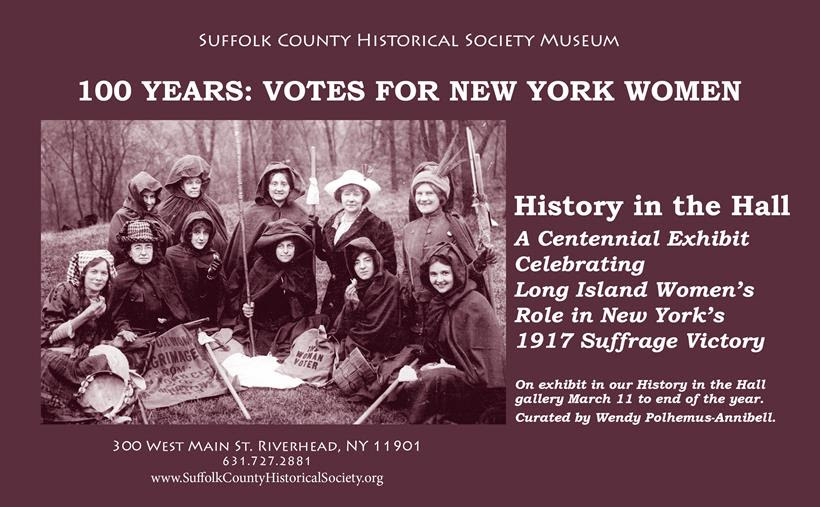
100 Years: Votes for New York Women, a Centennial Exhibit Celebrating Long Island Women’s Role in New York’s 1917 Suffrage Victory. On display March 11 to end of year. Curated by Wendy Polhemus-Annibell. Gallery Hours: Weds. – Sat., 10:00 am – 4:30 pm. When New York State women won the right to vote one hundred years ago—making 2017 the centennial of that historic civil rights victory—their success changed the national political landscape and was a critical tipping point on the road to a constitutional amendment. Our “History in the Hall” exhibit celebrates the centennial by narrating the stories of Long Island women activists who dedicated themselves to the powerful grassroots movement.
************************************************************
SCHS Photo of the Week: Click Here to Visit Webpage.
Visit: www.suffolkcountyhistoricalsociety.org
To view 2014 Photo of the Week pages click here.
To view 2015 Photo of the Week pages click here.
To View 2016 Photo of the Week pages click here.
~~~~~~~~~~~~~~~~~~~~~~~~~~~~~~~~~~~~~~~
PHOTO OF THE WEEK: March 4, 2017 — FROM THE SCHS LIBRARY ARCHIVES
“How shall we know it is us without our past?” – John Steinbeck
Mary Louise Booth, Yaphank
by Wendy Polhemus-Annibell, Librarian
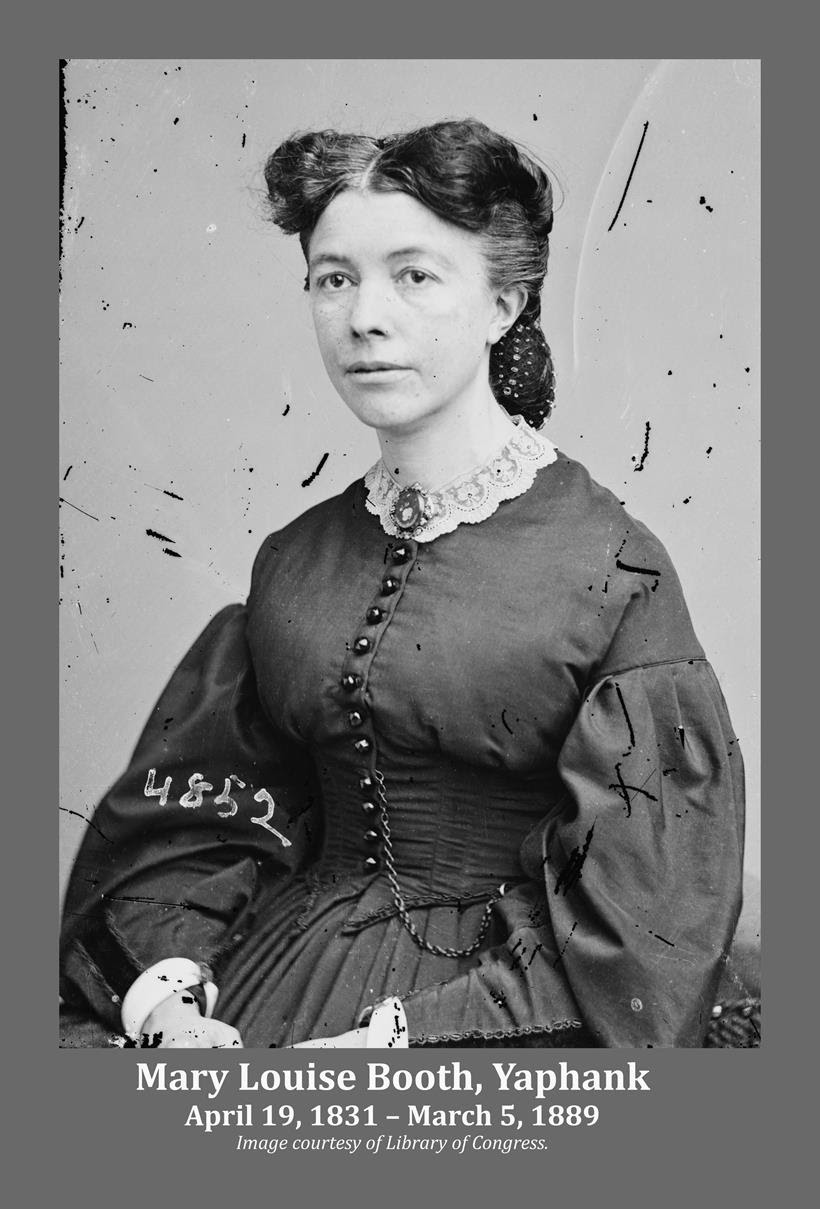
Mary Louise Booth (1831-1889) of Yaphank was an accomplished writer and translator who was most well-known for her anti-slavery work, but she was also strongly involved in the early suffrage movement. Descended on her father’s side from John Booth, who came to America about 1649, Mary was born in Millville (present-day Yaphank) as the eldest of four children to Nancy Monsell and William Chatfield Booth. Her father owned and operated a wooden mill and dye house in Yaphank, and in the winter he served as schoolmaster for the children of Yaphank.
Booth was a child prodigy. She was reading at the age of two, and reading classic literature before age five. She was fluent in both English and French (her mother’s family had fled France during the French Revolution), and she taught herself German, Italian, and Spanish. She taught school for a time, as her father believed teaching was the only suitable career for a woman, but Mary aspired to a literary career. She left home and moved to Manhattan, where she wrote articles for various literary magazines and landed her first paying job as a writer, for the New York Times.
Gaining national attention and recognition for her translations of French anti-slavery books during the Civil War, including a personal thank-you from President Lincoln for her role in supporting the Union cause, Mary Louise Booth also published books, including her History of the City of New York (1859), and served as Harper’s Bazaar’s first editor, a position she held for over twenty years.
Booth served as a delegate to the New York State Teachers Association Convention in 1857, and it was here that she met Susan B. Anthony and joined the women’s rights movement. After the Civil War, Booth joined the National Woman Suffrage Association. Although Booth was not a militant feminist, she exemplified the modern woman: She was productive and well paid, and her accomplishments found their way into the American consciousness.
Suggested Readings: Long Island and the Woman Suffrage Movement by Antonia Petrash; Women in Long Island’s Past by Natalie Naylor; and Long Island Women Activists and Innovators, edited by Natalie Naylor and Maureen Murphy.
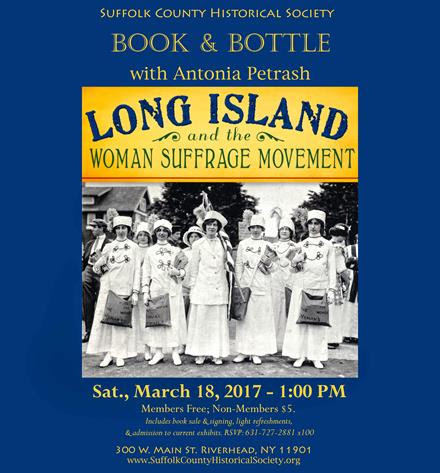
MARCH IS WOMEN’S HISTORY MONTH…Join us on Saturday, March 18 at 1:00 pm for a Book & Bottle talk by Antonia Petrash on Long Island and the Woman Suffrage Movement. Members Free; Non-Members $5. Includes light refreshments, museum admission, and book sale & signing. RSVP: 631-727-2881 x100.
************************************************************
SCHS Photo of the Week: Click Here to Visit Webpage.
Visit: www.suffolkcountyhistoricalsociety.org
To view 2014 Photo of the Week pages click here.
To view 2015 Photo of the Week pages click here.
To View 2016 Photo of the Week pages click here.
~~~~~~~~~~~~~~~~~~~~~~~~~~~~~~~~~~~~~~~
PHOTO OF THE WEEK: February 25, 2017 — FROM THE SCHS LIBRARY ARCHIVES
“How shall we know it is us without our past?” – John Steinbeck
Fort Salonga
by Wendy Polhemus-Annibell, Librarian
[To View Fullerton photo visit SCHS website] Fort Salonga, 1903: Wooded Slope, Trout Stream, and Cows Drinking, by Hal B. Fullerton. (Image from the Collection of the Suffolk County Historical Society Library Archives [149.7.831]. Copyright © Suffolk County Historical Society. All rights reserved.)
The hamlet known today as Fort Salonga was established by way of a deeded property from Sarah Smith, wife of Richard Smith, to her son Daniel in 1695. The deed identified 100 acres at the western part of Smithtown, near the border with Huntington, in an area then named Fresh Pond. Maps from the time period also refer to the area as Middleville, Meadow Glen, or Tredwell’s Neck. In the late 1690s, rumors spread that Captain Kidd’s ship, the Adventure Galley, had been seen off Tredwell’s Neck, and on some old maps one can find a spot marked “Kidd’s Money Hole.” Rumors still exist that a pirate’s treasure may be buried on the beach in Fort Salonga.
During the American Revolution, the British established a fortification at Tredwell’s Neck called Fort Slongo, named after one of the fort’s architects. This name shifted to Fort Salonga sometime in the 1800s.

Join us on Thurs., March 2, 6:00 pm for a Closing Reception & Curator’s Talk, Fullerton from the Photographer’s Perspective. This is the last chance to view Fullerton’s Long Island, our display of historic photographs of Long Island from our legendary Fullerton Collection. Free admission + wine and cheese. RSVP: 631-727-2881 x100.
************************************************************
SCHS Photo of the Week: Click Here to Visit Webpage.
Visit: www.suffolkcountyhistoricalsociety.org
To view 2014 Photo of the Week pages click here.
To view 2015 Photo of the Week pages click here.
To View 2016 Photo of the Week pages click here.
~~~~~~~~~~~~~~~~~~~~~~~~~~~~~~~~~~~~~~~
PHOTO OF THE WEEK: February 18, 2017 — FROM THE SCHS LIBRARY ARCHIVES
“How shall we know it is us without our past?” – John Steinbeck
Letter from George Washington, 1795
by Wendy Polhemus-Annibell, Librarian

Letter from George Washington to Nine Suffolk County Residents Who Had Expressed Opposition to the Jay Treaty of 1795. (Image from the Collection of the Suffolk County Historical Society Library Archives. Copyright © Suffolk County Historical Society. All rights reserved.)
This rare document turned up in the Southold home of Mary Dayton, whose ancestors were among New York state’s first judges. The letter, dated September 7, 1795, was addressed to Ms. Dayton’s great-great-great grandfather, Jared Landon of Cutchogue, and eight other Suffolk County residents who had expressed opposition to the Jay Treaty of 1795: David Hedges of Bridgehampton, Benjamin Huntting of Southampton, Abraham Miller of East Hampton, Benjamin Horton Jr. of Southold, Nicoll Floyd of Mastic, John Howard of Shelter Island, Josiah Reeve of Mattituck, and David Warren of Jamesport. Although we are unsure whether George Washington or a staffer actually penned the letter, it was issued from the president’s office. The letter reads:
“Gentlemen, I have received your letter of Aug 6 expressing your Sentiments on the Treatly lately negotiated between the United States and Great Britain. It is now generally known that the Treaty has received my Assent on the Condition proposed by the Senate; this was not given until after most mature deliberations. Not withstanding the Diversity of Opinion which has been manifested is much to be regretted, I cannot but hope that experience will show that the public interest required the Course which has been pursued. With due respect, I am Gentlemen, Your Obedient Geo. Washington.”
There was anger over Britain’s refusal to withdraw troops from the northwestern frontier, refusal to enter into commercial agreements, and mistreatment of crews on American ships. President Washington had sent Supreme Court Justice John Jay to negotiate with Britain, and Jay returned with a treaty in which some concessions had been gained, but not nearly as many as the American public had hoped for. The nine Suffolk County residents had sent a letter to Washington expressing doubts about the Jay Treaty that the young United States had recently signed with Great Britain.
Many Long Islanders had been imprisoned or forced to flee to Connecticut during the British occupation, and when they returned, many found that their possessions had been plundered and their homes wrecked by fire or cannonballs. In addition, Washington had been informed that David Hedges had spent seven years in a British lockup in Southampton. The President therefore took special pains to respond personally to these men of Suffolk County.
Suggested Reading: The Diary of George Washington From 1789 to 1791; Embracing the Opening of the First Congress, and His Tours Through New England, Long Island, and the Southern States, 1860.
************************************************************
SCHS Photo of the Week: Click Here to Visit Webpage.
Visit: www.suffolkcountyhistoricalsociety.org
To view 2014 Photo of the Week pages click here.
To view 2015 Photo of the Week pages click here.
To View 2016 Photo of the Week pages click here.
~~~~~~~~~~~~~~~~~~~~~~~~~~~~~~~~~~~~~~~
PHOTO OF THE WEEK: February 4, 2017 — FROM THE SCHS LIBRARY ARCHIVES
“How shall we know it is us without our past?” – John Steinbeck
Henry Highland Garnet (1815-1882)
by Wendy Polhemus-Annibell, Librarian

Henry Highland Garnet (1815-1882):
A Journey from Slave to Abolitionist to U.S. Ambassador
My whole life is consecrated to the cause of Liberty.
Wherever my lot shall be cast, I shall feel free
to raise my feeble voice for equal justice.
— Henry Highland Garnet, 1846
Although one of the most well-known African Americans of the nineteenth century, Henry Highland Garnet, sadly, is little remembered today. Even less remembered are his connections to Long Island and Suffolk County. As a young fugitive slave and an outspoken abolitionist, Garnet was given shelter by sympathizers on Long Island for several years. Quakers in Westbury took him in, and later they arranged for him to go farther east and be apprenticed to Epenetus Smith of Smithtown.
Despite his birth into the bondage of slavery, the loss of a limb, and the persistent discrimination and bigotry he faced, Garnet went on to achieve great successes: he was an effective orator and writer, prominent clergyman, educator, and diplomat. He was also one of the first African Americans to be appointed as a U.S. ambassador.
Henry Highland Garnet has the notable distinction of being the first African American to speak at the U.S. Capitol in Washington, DC. On Sunday, February 12, 1865, within days of Congress’s adoption of the 13th Amendment banning slavery, Rev. Garnet delivered a sermon in the Hall of the House of Representatives entitled “Let the Monster Perish” (go here to read it).
Visit our new Black History Month “History in the Hall” Exhibit to learn much more about the life and accomplishments of Henry Highland Garnet. The exhibit will run to March 3, 2017. Gallery Hours: Wednesday to Saturday, 10:00 am – 4:30 pm.
************************************************************
SCHS Photo of the Week: Click Here to Visit Webpage.
Visit: www.suffolkcountyhistoricalsociety.org
To view 2014 Photo of the Week pages click here.
To view 2015 Photo of the Week pages click here.
To View 2016 Photo of the Week pages click here.
~~~~~~~~~~~~~~~~~~~~~~~~~~~~~~~~~~~~~~~
PHOTO OF THE WEEK: February 4, 2017 — FROM THE SCHS LIBRARY ARCHIVES
“How shall we know it is us without our past?” – John Steinbeck
Pyrrhus Concer: Slave, Whaler, & Entrepreneur
from Southampton, 1814-1897
by Wendy Polhemus-Annibell, Librarian
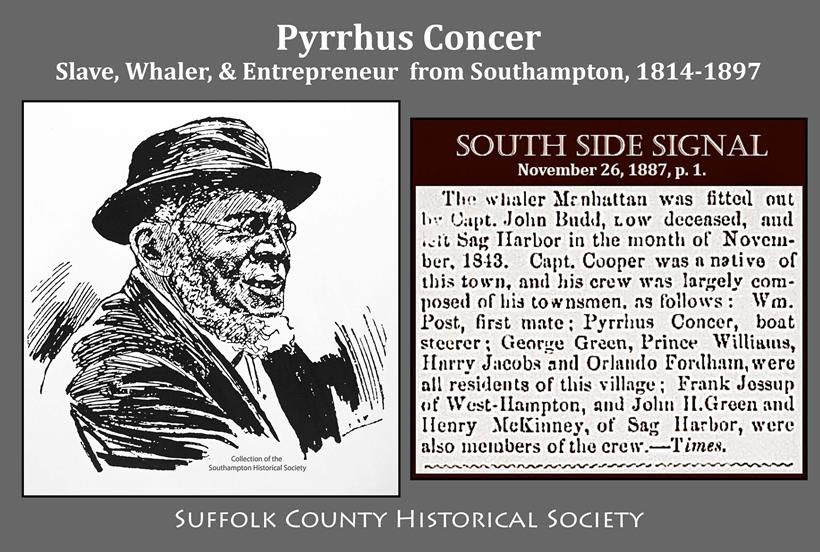
Pyrrhus Concer: Slave, Whaler, & Entrepreneur from Southampton, 1814-1897. Born a slave in Southampton in 1814, Pyrrhus Concer, as a free man, went whaling at the age of 18. He sailed as a common seaman during his first voyages and then was promoted to boatsteerer, a position of great importance on a whaling ship. The boatsteerer was responsible for guiding the whaleboat toward the targeted whale and for throwing the first harpoon, and then for holding the boat close to the whale while other shipmates killed the whale.
Concer sailed on the famous voyage of the Manhattan in 1848, captained by Mercator Cooper of Southampton, when it picked up several shipwrecked Japanese fishermen in the Pacific Ocean. The Manhattan took those fishermen from Japan home and thus became the first American ship to enter Tokyo Harbor, which at the time was closed to foreign ships. The Japanese were fascinated by Concer, the first person of African heritage they had ever seen, and treated him with curiosity and respect. After retiring from whaling, Concer headed for the goldfields of California for a short time before returning to Southampton, where he operated a ferry service on Lake Agawam.
Concer, who died at the age of 84 in his home at 51 Pond Lane in Southampton Village, left a legacy to the Presbyterian Church of Southampton and a fond memory. His obituary described him as “one of the most respected residents of the village.” The stone that marks the Southampton grave of Pyrrhus Concer bears this inscription:
Though born a slave
he possessed virtues
without which kings
are but slaves.
Though the historic Pyrrhus Concer home was demolished by the current property owners, efforts are under way to reconstruct the historic building. Learn more about this local effort at our February 11 Book & Bottle, Preserving the Legacy of Pyrrhus Concer with Drs. Allison Manfra McGovern and Georgette Grier-Key.
Admission is free for members, $5 for non-members, and includes light refreshments and admission to current exhibits. The Saturday event begins at 1:00 pm. Please reserve by calling 631-727-2881 x100.

************************************************************
SCHS Photo of the Week: Click Here to Visit Webpage.
Visit: www.suffolkcountyhistoricalsociety.org
To view 2014 Photo of the Week pages click here.
To view 2015 Photo of the Week pages click here.
To View 2016 Photo of the Week pages click here.
~~~~~~~~~~~~~~~~~~~~~~~~~~~~~~~~~~~~~~~
PHOTO OF THE WEEK: JANUARY 20, 2017 — FROM THE SCHS LIBRARY ARCHIVES
“How shall we know it is us without our past?” – John Steinbeck
Edward Daily, Babylon Town Supervisor, 1899 – 1912
by Wendy Polhemus-Annibell, Librarian
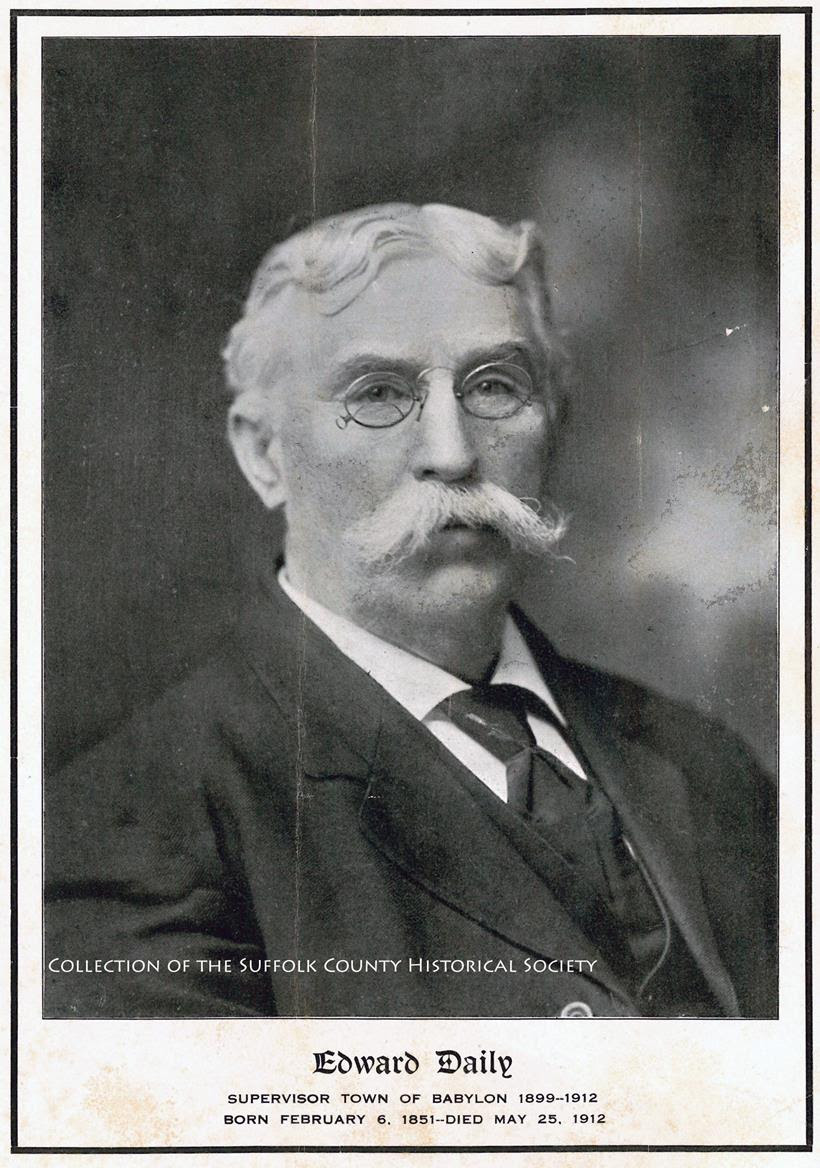
Edward Daily, Babylon Town Supervisor, 1899-1912. (Image from the Collection of the Suffolk County Historical Society Library Archives. Copyright Suffolk County Historical Society. All rights reserved.)
Edward Daily was a prominent citizen of Babylon, and was born there in 1851. He received his education from private tutors until age 10, when he entered the public school of his native town. As a teenager he first learned the paper-making trade, and then at age 16, having acquired a fondness for horses, he began working at a stable in Islip. Later he was the proprietor of a popular livery stable in Babylon, and in 1875 and 1876, he conducted an undertaking business in connection with his livery establishment.
Mr. Daly was a Democrat who served his party in several county conventions. He was elected to the office of highway commissioner and as overseer of the poor. He was also instrumental in the incorporation of the villege of Babylon, serving as its trustee and president. In 1899 Daily was elected to the office of Babylon Town Supervisor and served in that capacity until his death in 1912.
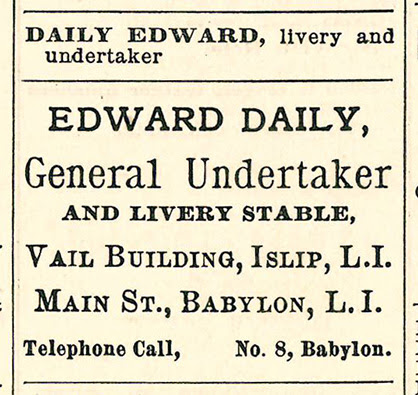
An ad from the 1897 Brooklyn and Long Island Business Directory.
~~~~~~~~~~~~~~~~~~~~~~~~~~~~~~
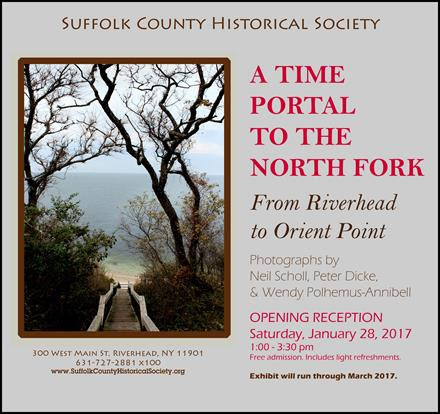
Join us tomorrow afternoon, Saturday, Jan. 28, 1:00 pm, for the Opening Reception of A Time Portal to the North Fork: Riverhead to Orient Point. The exhibit, featuring photographs of the North Fork by three local photographers, celebrates the agricultural and maritime heritage of the North Fork of Long Island. The photographs are available for sale, and a portion of the proceeds will benefit the Suffolk County Historical Society, Admission is free. Light refreshments will be served.
************************************************************
SCHS Photo of the Week: Click Here to Visit Webpage.
Visit: www.suffolkcountyhistoricalsociety.org
To view 2014 Photo of the Week pages click here.
To view 2015 Photo of the Week pages click here.
To View 2016 Photo of the Week pages click here.
~~~~~~~~~~~~~~~~~~~~~~~~~~~~~~~~~~~~~~~
___________________________
PHOTO OF THE WEEK: JANUARY 20, 2017 — FROM THE SCHS LIBRARY ARCHIVES
“How shall we know it is us without our past?” – John Steinbeck
——————————–
East End’s Corn Doctor, 1930s
by Wendy Polhemus-Annibell, Librarian

Guns and Photo of the East End’s Corn Doctor, 1930s. (Image from the Collection of the Suffolk County Historical Society. Copyright © Suffolk County Historical Society. All rights reserved.)
In 1932, “Doc” Frank Tuthill, an eccentric 68-year-old resident of Quogue, mysteriously disappeared. Affectionately known as the “Corn Doctor” (he was a chiropodist or foot doctor), Tuthill was also known as a “walking bank.” During the Great Depression years, he was frequently seen in and around East End hamlets wearing two coats, one over the other, all year round no matter the weather or season. Inside the pockets of his coats he carried with him tens of thousands of dollars in cash because he didn’t trust the banks. He also carried multiple revolvers to protect himself.
On a summer day in August of 1932, Tuthill drove his dilapidated Model T Ford roadster to a Riverhead pharmacy for a soda, and while he was there he was called to the phone and heard to say: “I’ll be there at 10 o’clock this evening!” and hung up. As Tuthill set out for his appointment later that night, he told his rooming house landlord that he had $10,000 in cash and several guns on his person, and if he didn’t return by the next day, the landlord should call the police.
Two weeks later, Tuthill’s bullet-ridden body was found in Hampton Bays, with the pockets of his coats turned inside out and his money stolen. Area residents Victor Downs and his wife Mitzie were accused of robbing and murdering Tuthill. Though sensational trials ensued in the Riverhead courts, no one was ever effectively prosecuted for his murder.
Shown here are the Corn Doctor’s British Bulldog revolvers alongside a photo of Frank Tuthill, Donated to the Suffolk County Historical Society in 1951, these two guns were among several that Tuthill always carried with him, the larger one being his favorite for many years.
************************************************************
SCHS Photo of the Week: Click Here to Visit Webpage.
Visit: www.suffolkcountyhistoricalsociety.org
To view 2014 Photo of the Week pages click here.
To view 2015 Photo of the Week pages click here.
To View 2016 Photo of the Week pages click here.
~~~~~~~~~~~~~~~~~~~~~~~~~~~~~~~~~~~~~~~
___________________________
PHOTO OF THE WEEK: JANUARY 14, 2017 — FROM THE SCHS LIBRARY ARCHIVES
“How shall we know it is us without our past?” – John Steinbeck
——————————–
Instructions for Census Agents, Albany, 1917
by Wendy Polhemus-Annibell, Librarian
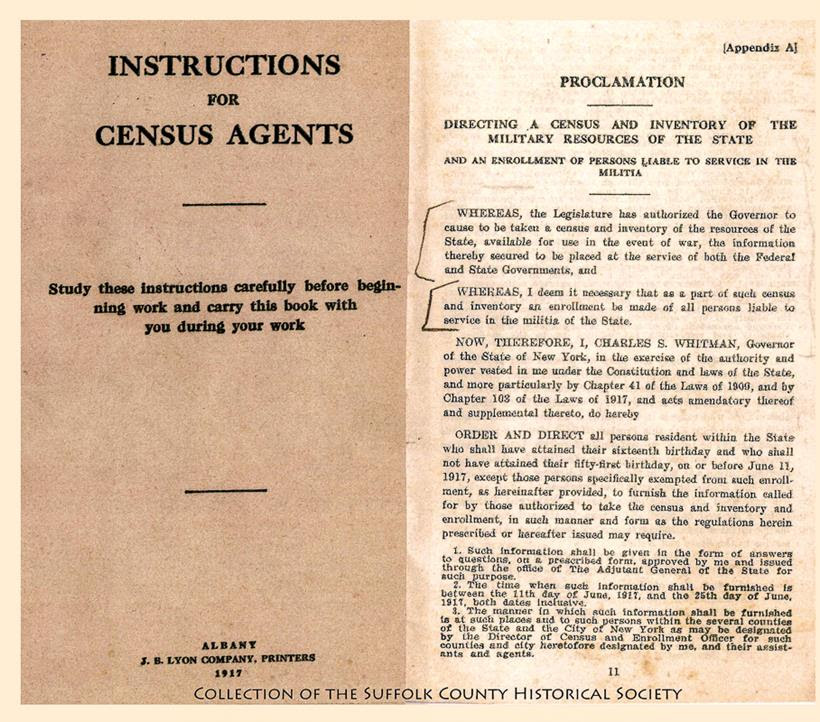
Instructions for Census Agents, Albany, 1917. (Image from the Collection of the Suffolk County Historical Society Library Archives. Copyright © Suffolk County Historical Society. All rights reserved.)
This 24-page instruction booklet was used by New York State military census takers in the spring of 1917 as the country was entering the world war. We believe our copy was owned by a census taker in Smithtown. Governor Charles S. Whitman ordered and directed that the census be taken. As the booklet explains…
“The Military Census consists primarily of the securing of certain information from the men and women of the State between the ages of 16 and 50 years, inclusive, in the form of answers to questions…approved by the Governor and issued through the office of the Adjutant General of the State. The reason for taking the Military Census at this time is that modern warfare demands, if the maximum strength of a nation is to be exerted, that the population shall be completely mobilized for war…. This consideration applies equally to men and women. It is hoped and expected that the present war will not necessitate any marked interference with the industrial organization of the State, nor require any widespread transplanting of the population, but it is deemed essential that the information should be secured at once so that if it should prove necessary to use it, it would be available without loss of time. This is indispensable to a proper distribution of the burden imposed by war.”
Sample Military Census questions: How old are you? What is your full name? In what city, town, or village do you live? Were you born in the United States? Are you white or colored? Are you a citizen of the United States? By birth or naturalization? Are you married? How many persons are dependent upon you for their entire support? In what industry or business are you engaged? Have you a trade or profession? Have you ever been employed in shipbuilding? For what particular arm of the military service do you believe yourself to be best fitted?
************************************************************
SCHS Photo of the Week: Click Here to Visit Webpage.
Visit: www.suffolkcountyhistoricalsociety.org
To view 2014 Photo of the Week pages click here.
To view 2015 Photo of the Week pages click here.
To View 2016 Photo of the Week pages click here.
___________________________
PHOTO OF THE WEEK: JANUARY 7, 2017 — FROM THE SCHS LIBRARY ARCHIVES
“How shall we know it is us without our past?” – John Steinbeck
——————————–
Riverhead Snow, 1920
by Wendy Polhemus-Annibell, Librarian

Riverhead Snow, 1920. (Image from the Hattie Aldrich Collection of the Suffolk County Historical
Society Library Archives. Copyright © Suffolk County Historical Society. All rights reserved.)
With the snowstorm approaching, we pulled this photograph from the early twentieth century of a snowy winter scene. Probably members of the Aldrich family, three adults, one child, and a dog are shown sitting on top of a snow bank following a snowstorm in Riverhead in March of 1920.
We will be closing at noon today [Saturday, January 7, 2017] due to the snow. Stay safe, and have a wonderful weekend!
************************************************************
SCHS Photo of the Week: Click Here to Visit Webpage.
Visit: www.suffolkcountyhistoricalsociety.org
To view 2014 Photo of the Week pages click here.
To view 2015 Photo of the Week pages click here.
To View 2016 Photo of the Week pages click here.
~~~~~~~~~~~~~~~~~~~~~~~~~~~~~~~~~
_____________________________________________________________________

